The Seagate Ironwolf Pro 24TB HDD Review
Seagate and their Ironwolf series of hard drives have fast become a mainstay of the NAS landscape in a relatively short time, considering their NAS HDD and eventual rebranding to Ironwolf in 2015/2016. In that time they have closed considerable ground on their biggest rival in this field, the WD Red series, and now although the brand first released Ironwolf Pro 20, 22 and now 24TB NAS Hard Drives in the last 18 months, they are now in the process of revising a number of these drives and introducing a new higher durability STX0000NT001 / STX0000NT001 series to join that existing the STX000NE001. These newer class of Prosumer/large-scale storage array NAS hard drives arrive with almost twice the workload rating, more than double the MTBF rating and still maintain the same high reported performance levels. All this said, why the sudden change? Perhaps facilitated by hardware shortages or due to the growing concerns of some users over larger capacities having the same workload rating of smaller capacities, leading to diminishing durability returns? Whatever the reason (more on that later), there is no denying that 24TB of storage in a single 3.5″ HDD casing is something to behold and today we are going to review this new massive drive from Seagate, benchmark it, test it with leading NAS brand Synology, discuss the differences with the existing Ironwolf Pro range and (hopefully) help you decide if it deserves your data? Let’s begin.
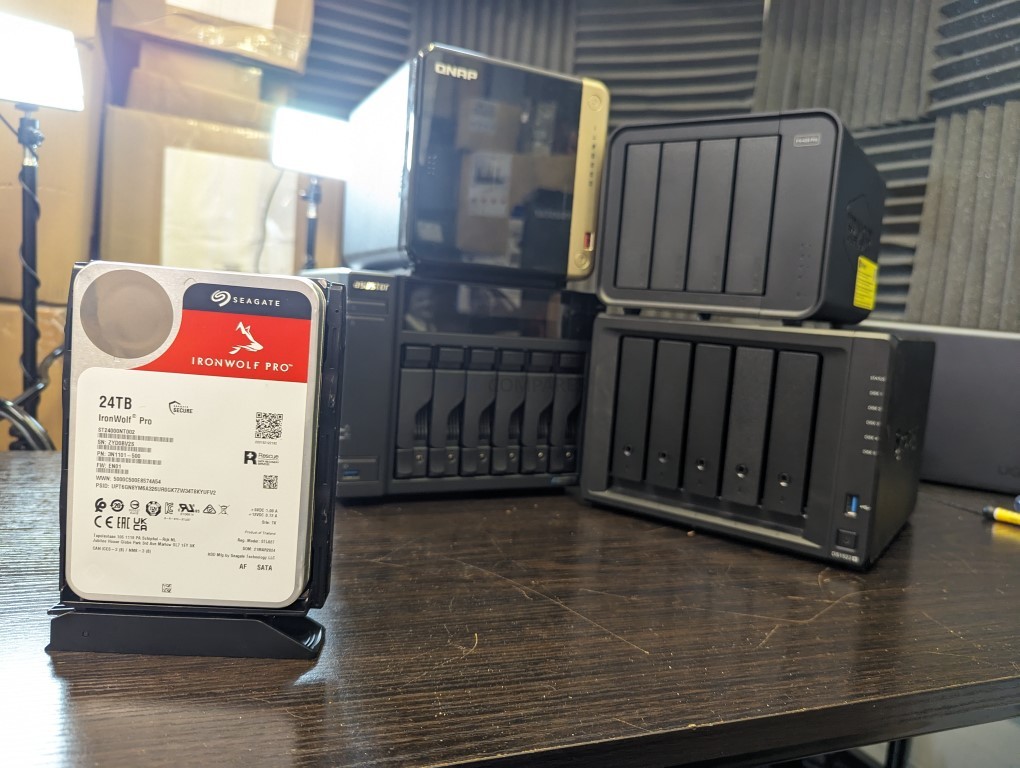
Seagate Ironwolf Pro 24TB Hard Drive Review – Quick Conclusion
There is no denying that Seagate certainly delivers on the prompted storage and performance that they have stated for the Ironwolf Pro 24TB NAS hard drive. This alongside fully tested and confirmed compatibility with Synology (though not by Synology themselves) devices means that you have a drive here that can turn any 4-Bay NAS into a staggering 96TB server in RAID 0 and 72TB RAID5 Storage data monster – let alone once you start thinking about rackmounts and hyperscale. The pricing of this 24TB is understandably high, but as always, when you start crunching down the ‘Price Per TB’, it ends up landing comfortably in the same region as other Pro class drives of a smaller capacity. As mentioned previously, I particularly appreciate that the workload discussion surrounding ‘Pro’ Class drives at 300TB/yr vs rapid HDD capacity growth is being addressed here with a 550TB/yr version to rival that of ‘Ent’ class drives – whatever the reason/motivation. With capacities getting higher and more ‘eggs being placed in baskets’, the durability of each individual drive in an array grows in importance, so the shift of these PRO class drives towards an ENTERPRISE class workload should be positively noted. The value of the Ironwolf Health Management tool is going to be something of debate and the inclusion of 3yrs data recovery services is a nice extra that (with any luck) few will need to use – but better to have them and not need them, than visa versa. As HDDs continue to increase in scale and Seagate (among other brands) continues to outline their plans to hit 50TB (so, halfway there with this one!) by the end of the decade, the Seagate Ironwolf Pro ST2400NT002 is another good example of an HDD that finds a sweet spot between price, durability and value. Just be aware that this is a drive designed for large-scale use and that means high operational noise and higher than typical power use than non-Pro and smaller cap drives!
Where to Buy a Product





![]()
![]()

VISIT RETAILER ➤






![]()
![]()

VISIT RETAILER ➤






![]()
![]()

VISIT RETAILER ➤






![]()
![]()

VISIT RETAILER ➤
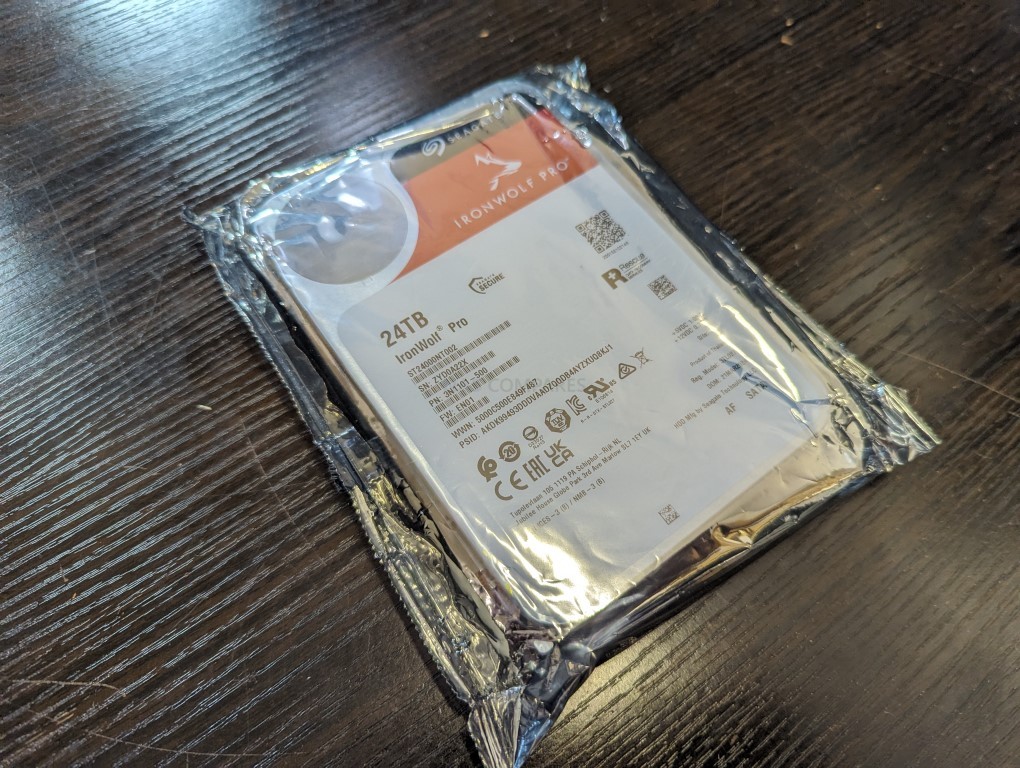
Seagate Ironwolf Pro 24TB Hard Drive Review – Design
The design of the Seagate Ironwolf Pro 24TB HDD remains largely unchanged in appearance compared with the most recent high-capacity releases at 24TB and 22TB. The 3.5″ casing is helium sealed and the new NT class of drives arrive with a change in the labelling to differentiate them from the NE Ironwolf Pro series. Perhaps this differentiation is the separate them for use in 24+ Bay servers (given the oddly open-ended ‘unlimited bay’ support on the spec sheets vs the ‘upto 24-Bays of the Ironwolf Pro till now). Typically NAS/SAN system that feature 24x and higher storage bays would have been urged to opt for the EXOS series (available in both SAS and SATA). Perhaps this is a means to open up and bracket the Hyper-Scale and Data Center tier up, as more and more medium-large business setup single/paired Rackmounts outside of the large-sclae cabinet settings of the past? It’s hard to say, as otherwise, what problem is a newer and more durable Ironwolf Pro drive solving?

One argument might be the growing question of workload ratings on HDDs vs Growing Capacities and how they are starting to result in reduced margins of durability. The general rule of thumb when it has come to Hard drives for 24×7 server deployment is:
- Standard Class Server Drives (so, upto 8 Bays of storage, small-medium Business deployment) is 180TB workload a year over the 3yr warranty
- Large Scale Server Drives (above 8 Bays and upto 24 Bays for Higher-end business and large-scale deployment) at 300TB workload per year over the 5yr Warranty
- Enterprise/Hyperscale Server Drives (i.e Data Center, with theoretically limitless Bay numbers, factoring expansions and growth) at 550TB workload per year over the 5yr Warranty
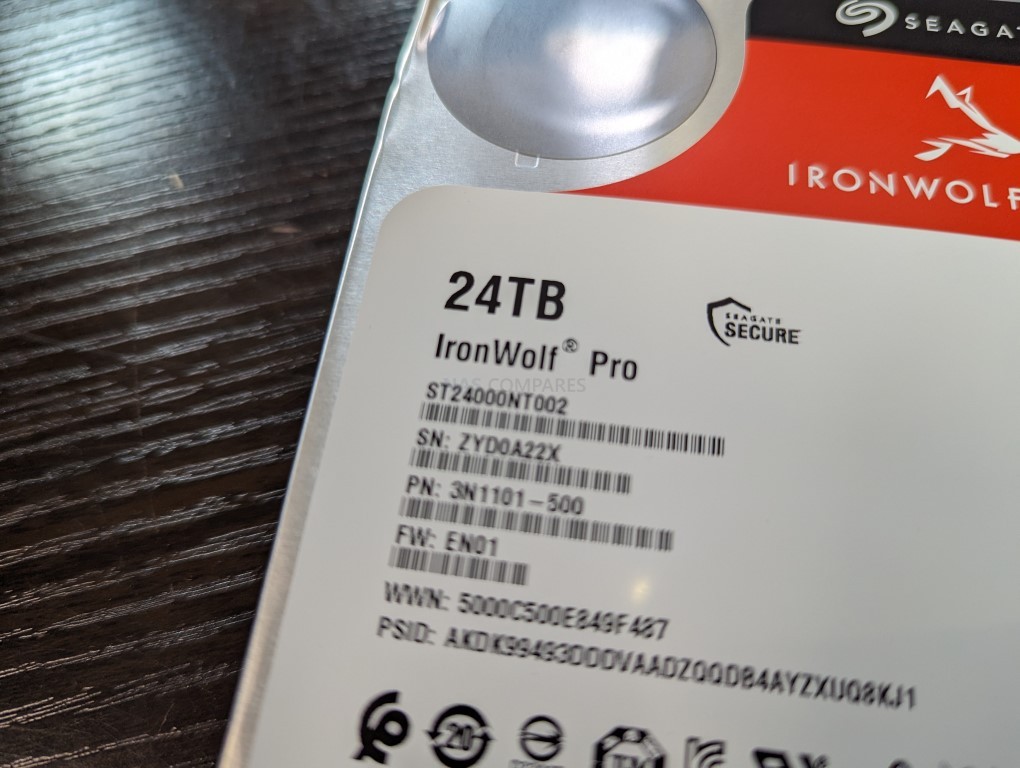
Now the Seagate Ironwolf Pro 24TB is branded as a ‘Pro’ class drive (the middle one, above), however it arrives with a 550TB Workload rating, putting it well into the Enterprise bracket and treading on the toes of Seagates EXOS series – though lacking the SAS and Encryption options of EXOS options. However, the general rules of 180/300/550TB respective workloads on each tier begin to fall down a little when you factor that a 1TB drive that has a 300TB workload at 210MB/s performance and a 24TB that is also at 300TB workload annually, but 285MB/s max transfer will not only hit that workload limit quicker – but there is also the question of how this translates over time vs the available storage space and writes over time! Therefore the newer gen Seagate Ironwolf Pro ST2000NT001 Hard Drive arriving with 550TB/yr (alongside NT versions of many of the other lower capacities) does elevate this point somewhat for those users in between the Large Scale and Hyperscale/data center.
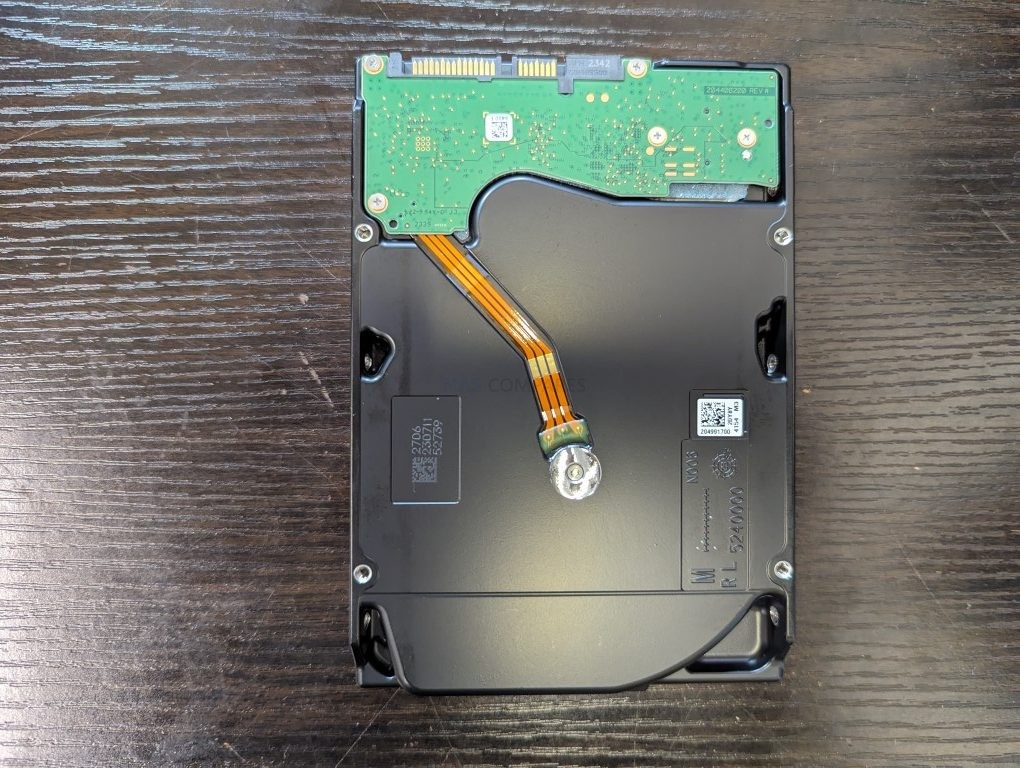
The 24TB in the ST2400NT001=2 is spread over 10 platters of 2.4TB each, made possible via the drive being helium sealed. This reduces potential internal drag and friction between platters, maintains the balance and allows much thinner platters to be used. Spinning at 7200RPM, the platters feature dual-plane balancing (known as AgileArray) also time-limited error recovery (TLER), which ensures the drive reading head isn’t delayed in intermittent read errors and can restart quickly to increase access when needed.
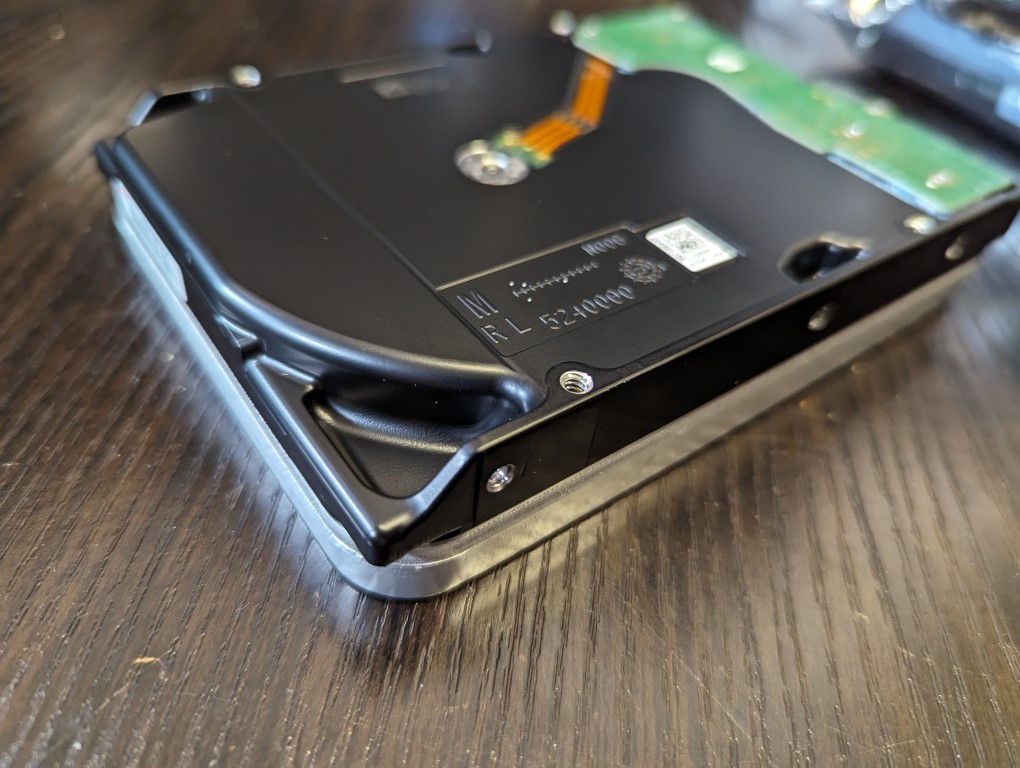
The 10 platters spinning at 7200RPM are also accompanied by 256MB of caching on board, which really surprised me, giving most of Seagate’s competitors have hit the 512MB cache level at this capacity tier. Having half the chance of its rivals does not seem to diminish both the performance or the sustained performance either.
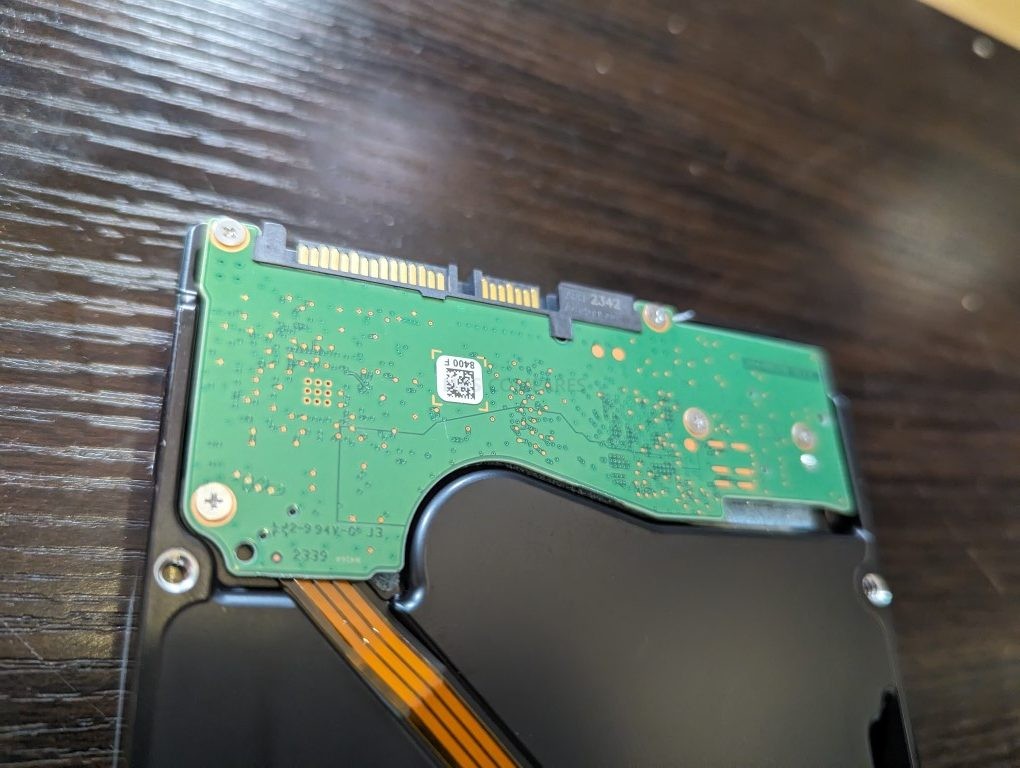
As mentioned, the Seagate Ironwolf Pro HDD series only arrives in SATA. Although I can understand that Segaate does not want to overlap TOO much with their EXOS range that they already have done, there are an increasing number of SAS NAS solutions arriving on the market (with both Synology and QNAP both increasing their range of solutions in this direction noticeably for their 2022/2023 generations). Yes, users could just go for a suitable SAS EXOS option, but then they lose out on the Rescue Data Recovery services and Ironwolf Health management on the drive.
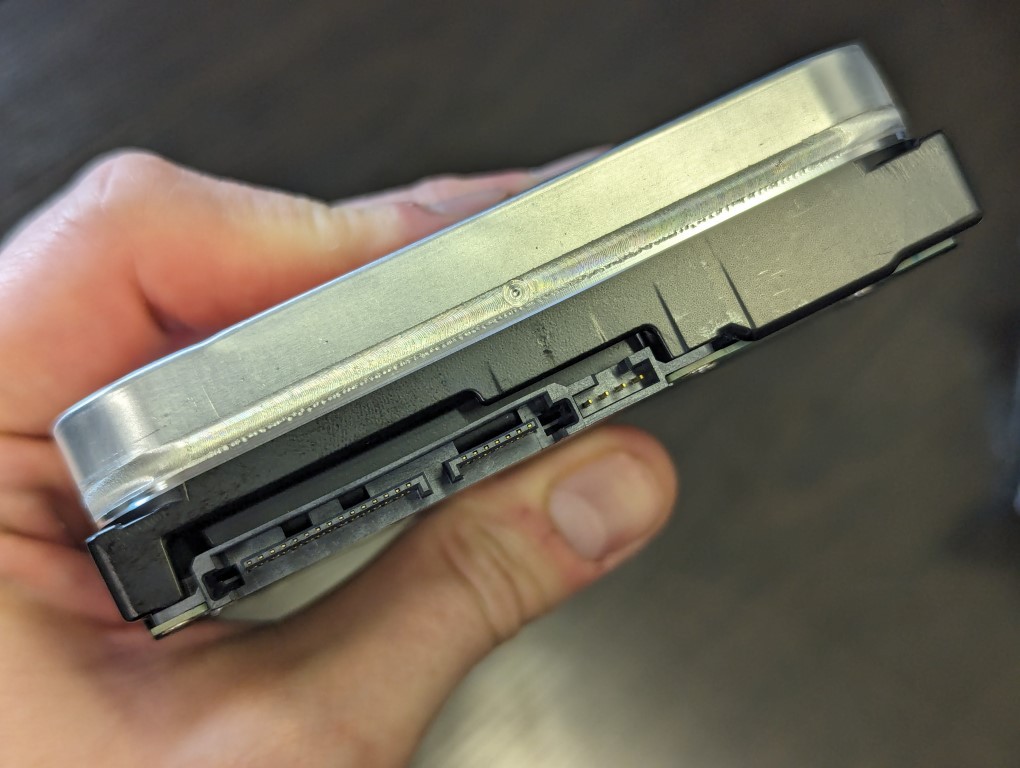
Overall, any improvements or changes in the build/construction of the Seagate Ironwolf Pro 24TB ST2400NT002 HDD over the rest of the range and/or the previous NE version are all internal. We have to take Seagate at their word on the effective doubling of the durability rating, but given their pedigree in the EXOS enterprise series, I have little doubt in this. Although the Ironwolf Pro 24TB is not the only NAS drive in the market right now that is breaking the 24 Terabyte level, it does arrive with a couple of things that many others don’t that we should cover – the included Data Recovery services and the Ironwolf Health Management tool for NAS for a start. But MOST IMPORTANTLY, the Seagate IW Pro 24TB is CMR (conventional Magnetic recording) and not SMR (Shingled Magnetic Recording – that latter of which is what the bulk of other NAS brands offer drives at this scale in. However, larger scale storage users will always opt for CMR drives and Seagate (unlike WD) have done a fantastic job of ensuring all their NAS drive series are CMR.
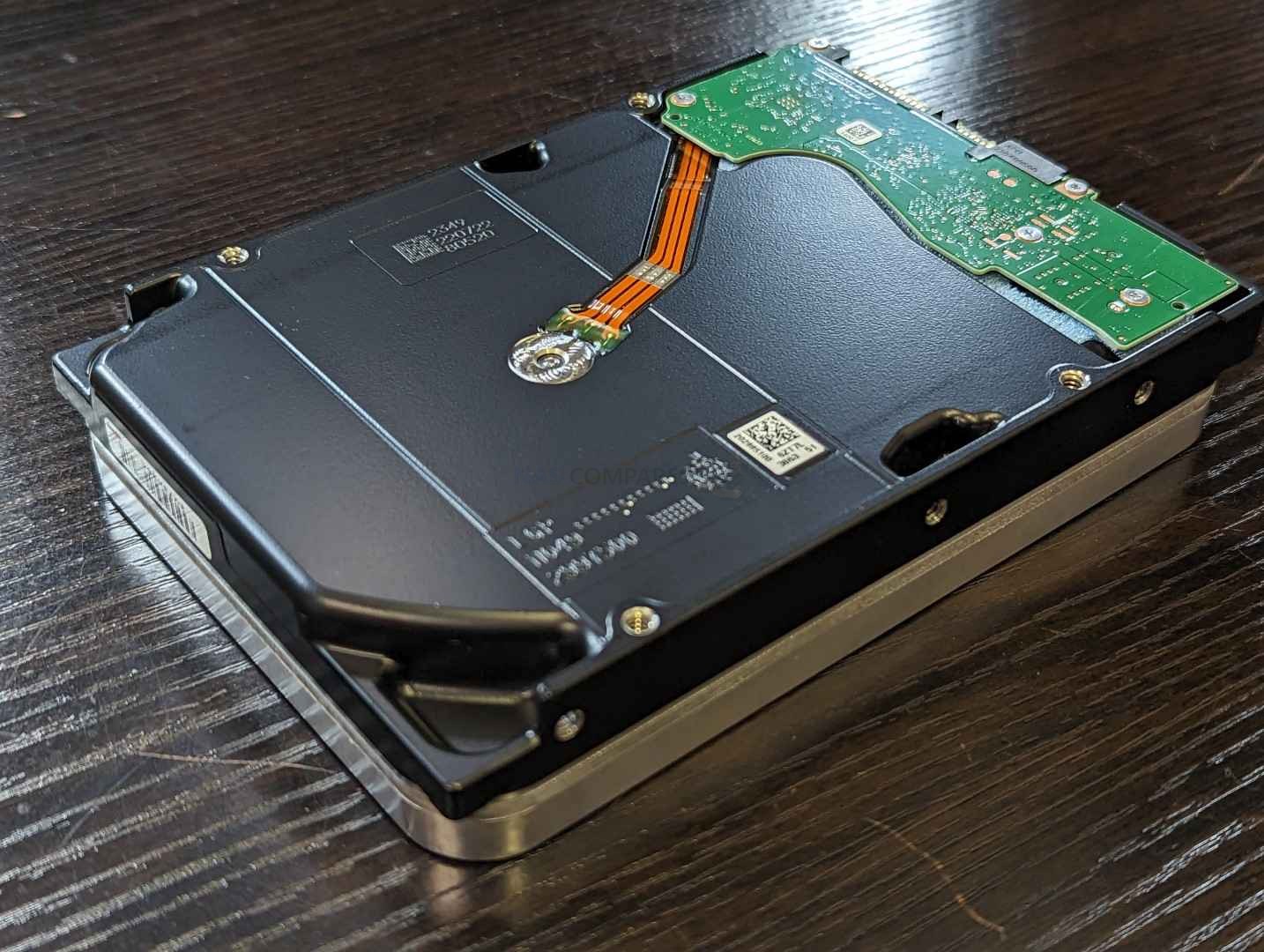
Is Seagate Ironwolf Health Management and Rescue Recovery Services Worth Caring About?
For those that are not aware, the Seagate Rescue+ package is a data recovery service that is included with your Ironwolf and Ironwolf Pro drives that, alongside your 3/5-year warranty, includes an additional 3 years of data recovery services. What that means is that if your drive fails through no fault of your own within reason (so, no, not smashing it with a hammer), you can send the drive off to the Seagate recovery labs and they will try to get that data back. From accidental deletion, all the way through to mechanical and forensic level recovery, this is an impressive inclusion! You should still factor other safety nets in your architecture (backups, UPS, RAID, etc) but given the cost of data recovery services (costing anything from hundreds to thousands of pounds), this is a very, VERY useful inclusion when you need it. This plus an already normally lower price point than Pro series drives in the WD Red series means that the Seagate Ironwolf hard drives still manage to be the better value choice for alot of users, especially when including the Rescue recovery included. They are also the only 3rd party NAS hard drive brand that has a tool to monitor drive health available on practically ALL the NAS software GUIs in the market, in Seagate Ironwolf Health Management. Here is part one of a two-part video series on the NASComapres YouTube channel were we showed the Seagate Rescue Recovery service (arguably, in a very extreme fashion!):
You can find out more on the Rescue service and its Pros/Cons in the video below. Otherwise there is another video detailing a guide on what to expect from data recovery costs/fees etc in a video from 2021:
Seagate Ironwolf Pro 24TB Hard Drive Review – Testing
Testing the Seagate Ironwolf Pro 24TB is going to be performed across multiple methods, but still rather unconventional. This drive is designed for deployment in large # Bay servers, but although I have several NAS in the studio that could accommodate this frequency of drives, I do not have sufficient Seagate Ironwolf Pro 24TB units. Therefore the testing I have conducted are all examples of single-drive performance. These will include several PC testing sessions using popular and recommended storage testing applications and two NAS tests involving Synology and QNAP.
- Windows 10 Pro Desktop System
- Intel i5 11400 Rocket Lake – 6-Core 2.6/4.4Ghz
- 16GB DDR4 2666MHz Memory
- Intel B560M mATX Motherboard
- OS Storage, Seagate Firecuda 120 SSD
- Test Hard Drive connected to a Sabrent USB 3.2 Gen 2 10Gb/s external dock
- Synology test was conducted on a DS923+ NAS using the system’s own benchmarking tool
These last tests are important as not only is the Seagate Ironwolf Pro 24TB HDD designed for NAS use, but also at the time of writing neither brand lists this hard drive as compatible. There is more to this though that I will touch on later.
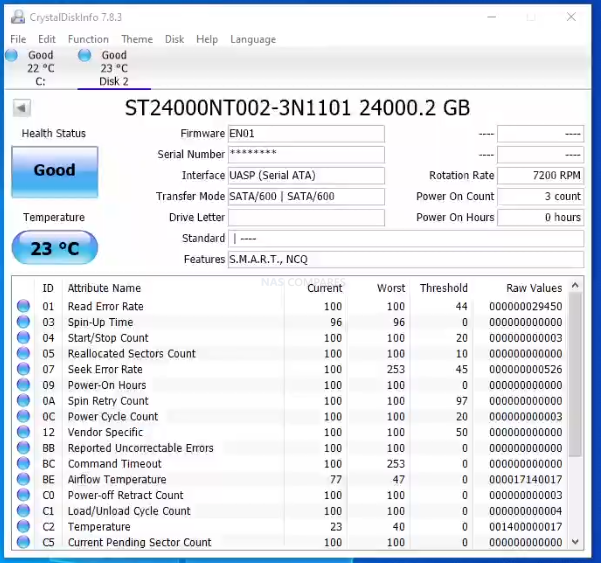
The first test involved using CrystalDisk. I performed tests on 1GB, 4GB and 16GB test files, as well as mixed 70/30% R/W. The results were consistent and largely lived up to Seagate’s claims here.
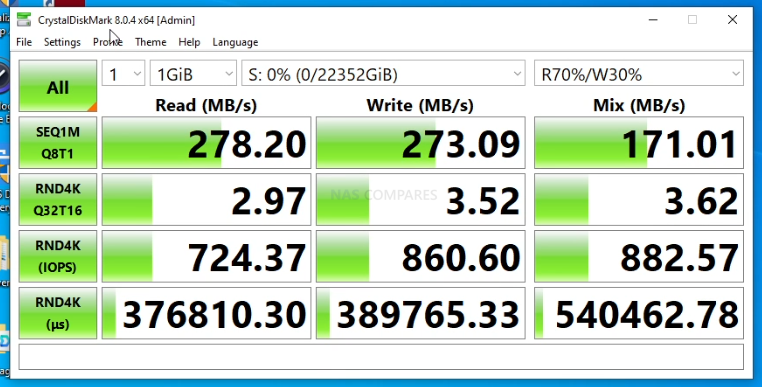 |
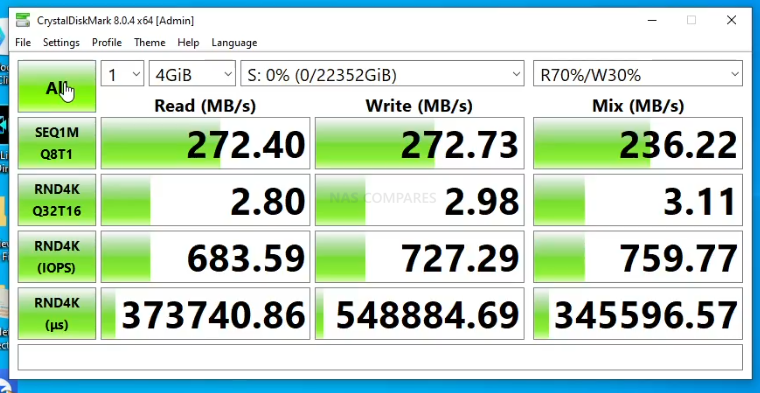 |
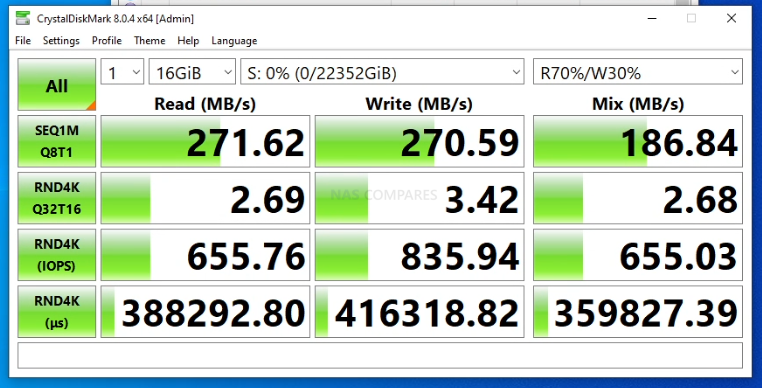 |
|
The next test used ATTO disk benchmark and this one used a 256MB, 1GB and 4GB test file in the same windows PC test environment. However, I also included the IOPS. The random 4K operations of a hard drive will typically be hugely dwarfed by those of SSDs, but enterprise HDDs and pro series drives still tend to rate noticeably higher than domestic HDD and standard-class NAS HDDs on this score.
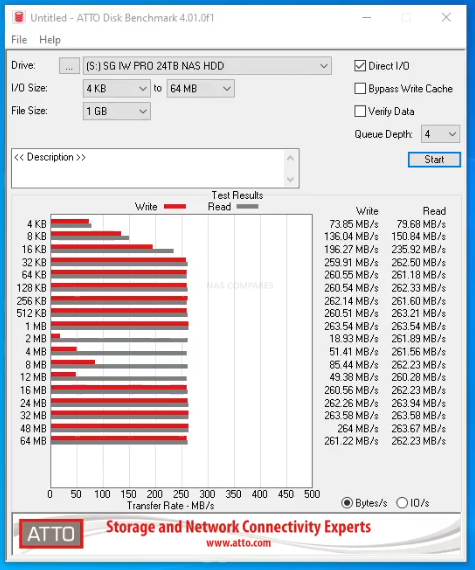 |
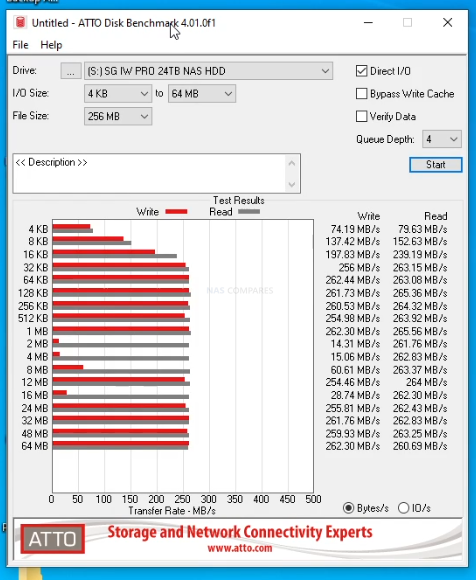 |
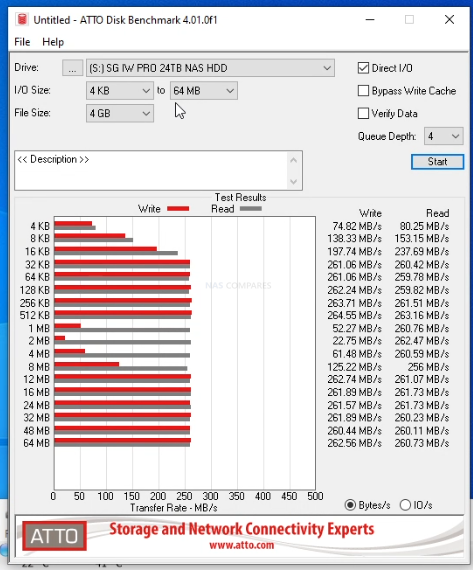 |
|
In order to conduct a windows performance test, I copied 20GB of mixed files over to the drive as a separate disk. The result was consistent performance and the transfer, averaging at 205MB/s on the windows transfer overall and peaking at 260MB/s. Although this is lower than the transfer rates stated by Seagate and in the synthetic tests above, this is perfectly understandable when dealing with this high volume of small/differing date, compared with the largely Sequential Data tests stated elsewhere.
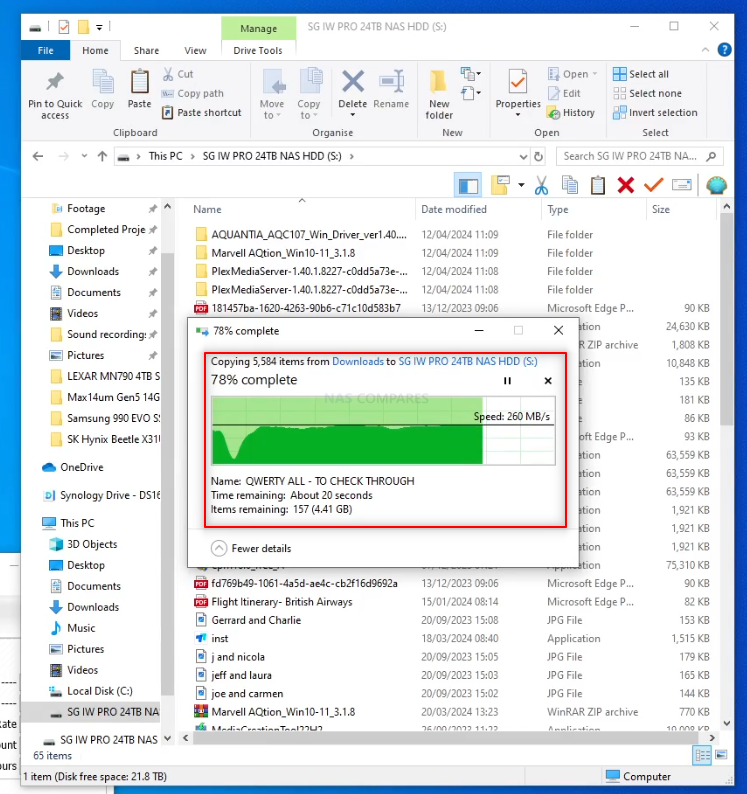
20GB Windows Transfer
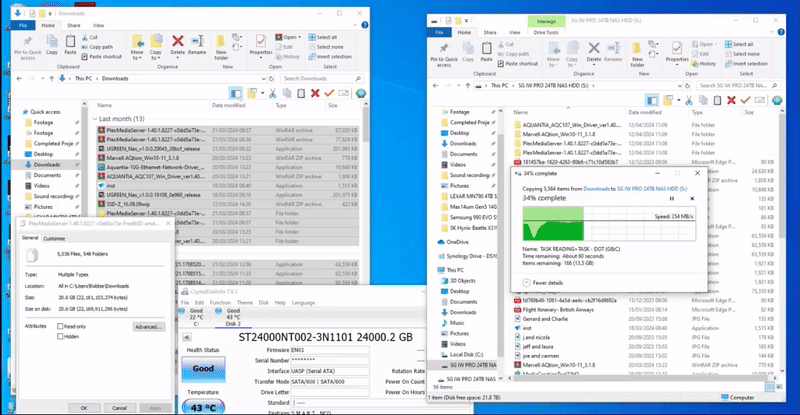
Synology NAS Testing with the Seagate Ironwolf Pro 24TB Hard Drive
Now, before I move on to the NAS testing. It is worth highlighting a couple of important factors with regard to the Seagate Ironwolf Pro 24TB and the support available from each NAS brand I am focusing on for the testing. Now, Synology is the ONLY NAS brand in the market that also has its own first-party HDDs available to users too. These are Originally Toshiba Enterprise-grade produced hard disks that have had a Synology-specific firmware applied to them. Now, why is this relevant? Well, because some larger-scale Synology products in 2021 onwards do not list other 3rd Party HDDs as compatible. Even then, if you look up some of the older 2020 released NAS drives currently in the market (such as the DS920+ for example), they DO list HDDs from the likes of Seagate Ironwolf (and their EXOS and Skyhawk series) BUT they do not list drives larger than 18TB at the time of writing. This is an odd stance by the brand, when larger-scale 24TB and 22TB hard drives are available in the market and designed for NAS.
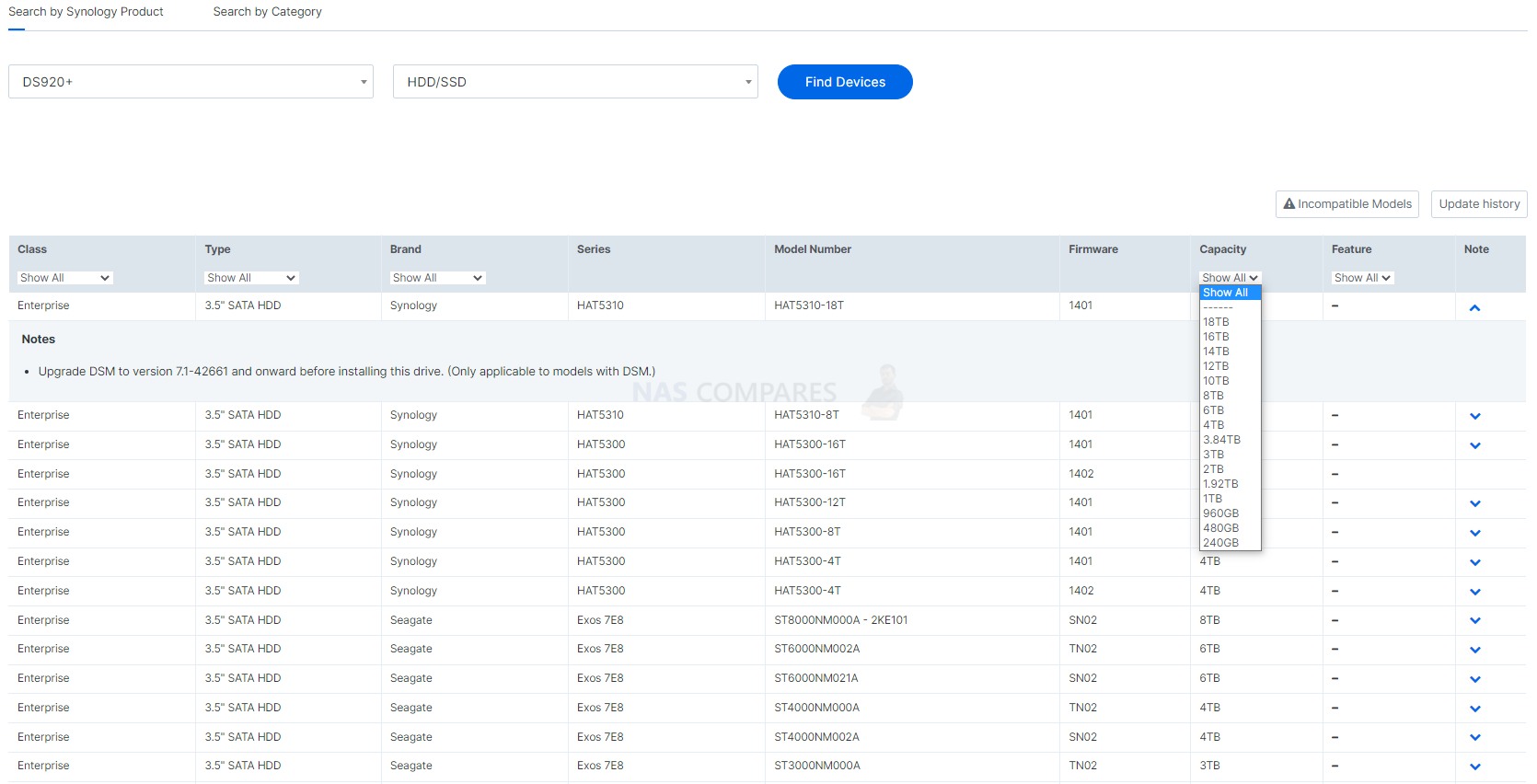
If you install an HDD or SSD inside a Synology system with the latest version of their software platform DSM, but the HDD in question is not on the compatibility list, you are greeted by a message that will detail that the drive is not recommended in the storage manager.
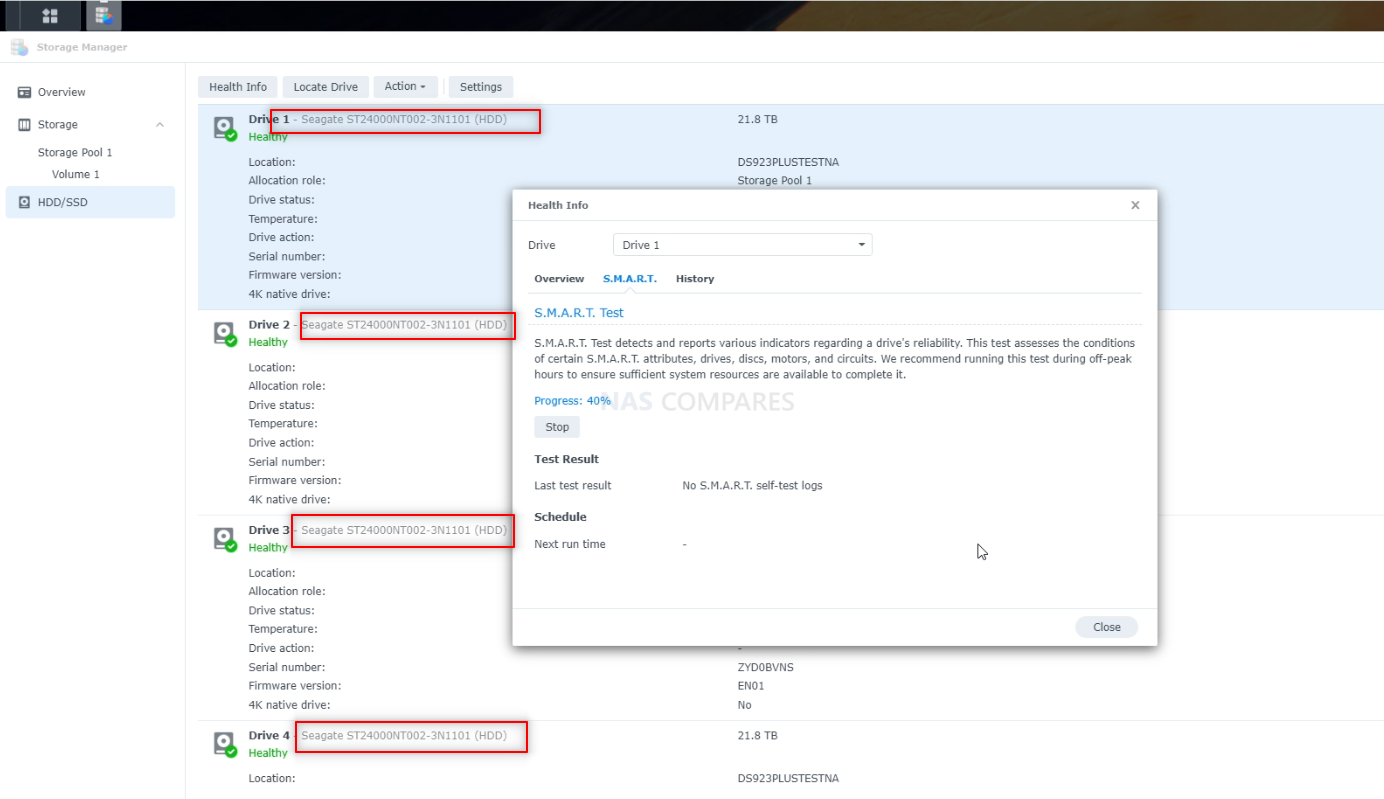
You can still use the HDD for Storage Pools, Volumes, Hot-spares, etc, but it is an oddly jarring message for some. Of course, this is the current compatibility of this HDD at the time of writing and may well change in the future as further HDD capacities arrive and additional compatibility testing takes place.
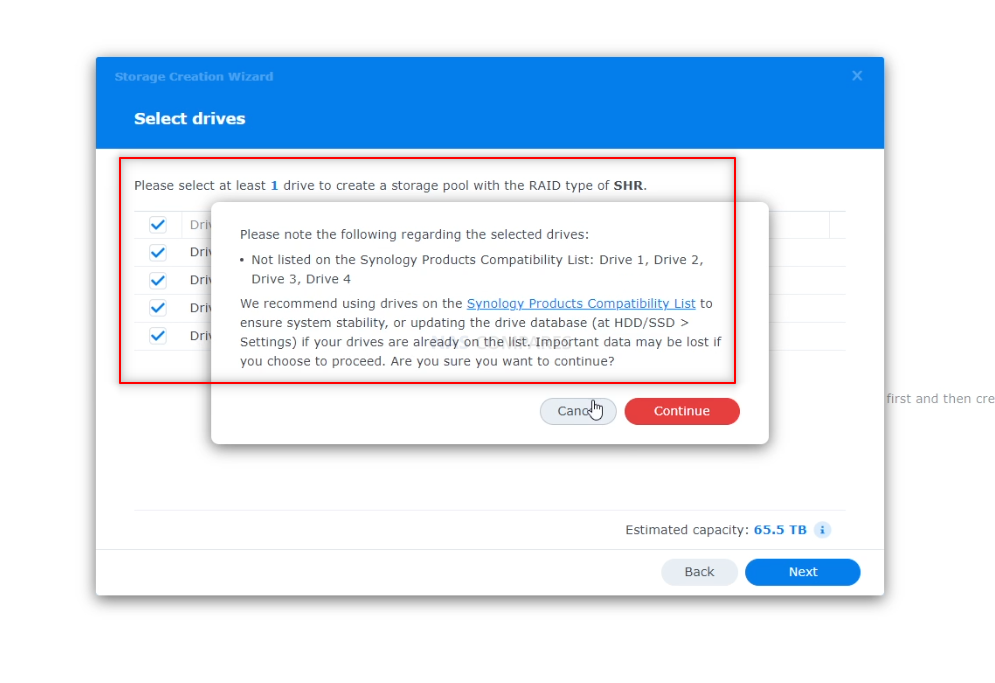
Nevertheless, you can still push through this warning and proceed to test the performance of the Seagate Ironwolf Pro 24TB HDD from within the Synology Storage Manager. Here are the results.
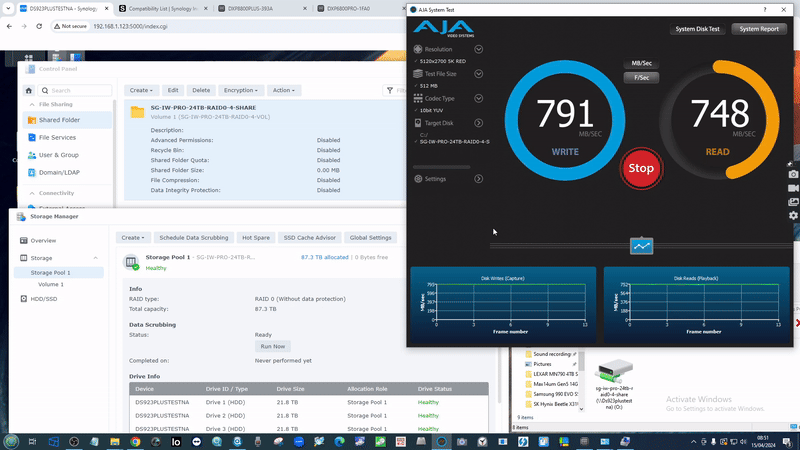
Noise Testing the Seagate Ironwolf Pro 24TB NAS Hard Drive

This is something that is often overlooked when users are getting excited about bigger and bigger HDDs entering the market and the Seagate Ironwolf Pro 24TB is no exception to this – NOISE! Because of the sheer scale of hardware that is getting packed into these larger capacity 3.5″ HDD casing and the more industrious hardware inside that needs to perform 24×7 durably, operational noise is unavoidable. Once you exceed around 8-10TB (HDD brand dependant), the increased platters and heavier duty actuator/arm mechanism needs to be a grat deal more reactive (due to the larger space that is needed to be covered ad-hoc. The Seagate ST2400NT002 24TB is a pretty spot-on example of this and although you are getting some great performance, it is achieved with a large amount of mechanical work under the bonnet. Now, if you are running a larger-scale data center/rackmount style setup, this is not going to be much of a barrier. As those kinds of server will have multiple fans and use horizontal pressure fan cooling – so they will be much louder than the drives! However, in more modest 4-8 Bay desktop NAS systems, its a different story, as these use smaller/quieter fans and alongside being more conductive of vibration, the noise of these drives in operation will be a great deal more obvious.
Here is an example of four Seagate Ironwolf Pro HDDs in a Synology DS923 4-Bay NAS, running an intense 4K IOPS benchmark on the drives (likely the LOUDEST THING you will ever hear, so this is not truly representative of idle/standby/low use):
If you want a better idea of typical operational noise and noise when booting the drive with the Seagate Ironwolf Pro 24TBs, watch the middle portion of the YouTube review HERE. Regardless, if you are sensitive to noise, will be in close proximity to the NAS device (direct 10GbE editing?) and will be running a smaller scale NAS system – then these new 24TB HDDs might not be quite your cup of tea!
Seagate Ironwolf Pro 24TB Hard Drive Review – Conclusion
There is no denying that Seagate certainly delivers on the prompted storage and performance that they have stated for the Ironwolf Pro 24TB NAS hard drive. This alongside fully tested and confirmed compatibility with Synology (though not by Synology themselves) devices means that you have a drive here that can turn any 4-Bay NAS into a staggering 96TB server in RAID 0 and 72TB RAID5 Storage data monster – let alone once you start thinking about rackmounts and hyperscale. The pricing of this 24TB is understandably high, but as always, when you start crunching down the ‘Price Per TB’, it ends up landing comfortably in the same region as other Pro class drives of a smaller capacity. As mentioned previously, I particularly appreciate that the workload discussion surrounding ‘Pro’ Class drives at 300TB/yr vs rapid HDD capacity growth is being addressed here with a 550TB/yr version to rival that of ‘Ent’ class drives – whatever the reason/motivation. With capacities getting higher and more ‘eggs being placed in baskets’, the durability of each individual drive in an array grows in importance, so the shift of these PRO class drives towards an ENTERPRISE class workload should be positively noted. The value of the Ironwolf Health Management tool is going to be something of debate and the inclusion of 3yrs data recovery services is a nice extra that (with any luck) few will need to use – but better to have them and not need them, than visa versa. As HDDs continue to increase in scale and Seagate (among other brands) continues to outline their plans to hit 50TB (so, halfway there with this one!) by the end of the decade, the Seagate Ironwolf Pro ST2400NT002 is another good example of an HDD that finds a sweet spot between price, durability and value. Just be aware that this is a drive designed for large-scale use and that means high operational noise and higher than typical power use than non-Pro and smaller cap drives!
| PROs of the Seagate Ironwolf Pro 24TB | CONs of the Seagate Ironwolf Pro 24TB |
|
|
🔒 Join Inner Circle
Get an alert every time something gets added to this specific article!
This description contains links to Amazon. These links will take you to some of the products mentioned in today's content. As an Amazon Associate, I earn from qualifying purchases. Visit the NASCompares Deal Finder to find the best place to buy this device in your region, based on Service, Support and Reputation - Just Search for your NAS Drive in the Box Below
Need Advice on Data Storage from an Expert?
Finally, for free advice about your setup, just leave a message in the comments below here at NASCompares.com and we will get back to you. Need Help?
Where possible (and where appropriate) please provide as much information about your requirements, as then I can arrange the best answer and solution to your needs. Do not worry about your e-mail address being required, it will NOT be used in a mailing list and will NOT be used in any way other than to respond to your enquiry.
Need Help?
Where possible (and where appropriate) please provide as much information about your requirements, as then I can arrange the best answer and solution to your needs. Do not worry about your e-mail address being required, it will NOT be used in a mailing list and will NOT be used in any way other than to respond to your enquiry.

|
 |
Why Do Cheap NAS Boxes EXIST????
Minisforum N5 Pro NAS - Should You Buy?
UGREEN DH4300 & DH2300 NAS Revealed - Good Value?
Aoostar WTR Max NAS - Should You Buy?
Xyber Hydra N150 NAS Review - Is This COOL?
Minisforum N5 Pro vs Aoostar WTR Max - The BIG Showdown
Access content via Patreon or KO-FI







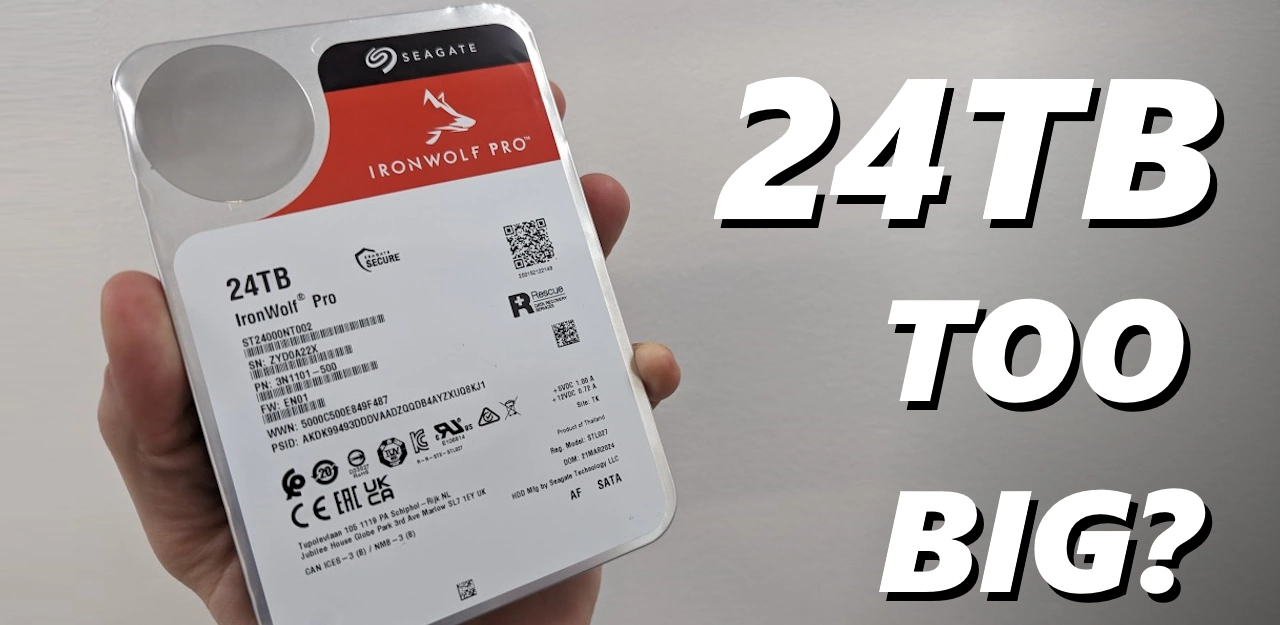




Hello, Is possible to insert these HDs into a Synology 916+? Thanks
REPLY ON YOUTUBE
Hello, Is possible to insert these HDs into a Synology 916+? Thanks
REPLY ON YOUTUBE
I already have a 200TB NAS and its too small 🙁
REPLY ON YOUTUBE
I can’t justify having less than 96TB storage when all the smaller drives are dramatically more expensive per-TB.
REPLY ON YOUTUBE
Im gonna stick it on a PC
REPLY ON YOUTUBE
Lets talk about backups
REPLY ON YOUTUBE
I want to put it in a windows PC actually
REPLY ON YOUTUBE
does anyone know how he got the 24tb drive to be recognized by the nas 923+ because every time i try to install dsm it says it’s incompatible
REPLY ON YOUTUBE
I’ve actually got 4 of these on order for my DS1522+. I’ll keep one bay open since I thought 5 would be overkill (RAID5).
REPLY ON YOUTUBE
If I install 10 of these with parity, ZFS will leave me with up to 3TB of usable space.
REPLY ON YOUTUBE
I am in the midst of this process and am sick to my stomach over the situation. I’m a retired pentioner. Have an old HP laptop. Not damaged just dead. took it to several places just to retrieve the documents. No luck. Finally sent it off to a big company and now i feel like a hostage. They have the drive. They say they can access it. Cannot provide me with a list of what is one it. Want 2500 American dollars just to rescue Word documents. Very discouraging. Cannot ever afford this.
REPLY ON YOUTUBE
…. and Seagate shipped 36 TB drives last week making this video obsolete 9 months later. 50% more capacity! 😀
REPLY ON YOUTUBE
One word of advice: go straight to the point, this video should be 10 minutes
REPLY ON YOUTUBE
Oh yes I do ????
REPLY ON YOUTUBE
I put 6 of these in my UGreen DXP6800 Pro and 4 in my UGreen DXP4800+. No problems with compatibility and getting transfer speeds as advertised in a btrf Raid 5 config. Expensive yes, but was worth the peace of mind for future proofing for me.
REPLY ON YOUTUBE
As it happens my (two) NAS are 24TB each. I have just bought a 24TB Seagate to use as a third backup. I will keep this offsite and bring it in monthly to backup the NAS. I also bought an ABS protective case for it at a total just over £450.
REPLY ON YOUTUBE
so why can’t you put 2x24tb to inside your gaming pc i have a Seagate 10tb and 6tb and also a 2tb in my gaming pc + 2tb mvme for c/drive and a 4tb mvme for Imediat stuff
REPLY ON YOUTUBE
Mewy są najlepsze.Pozdrawiam z Polski,jeśli wiesz gdzie to miejsce w ogóle jest!
REPLY ON YOUTUBE
A long time ago I told my mother that nobody needs 128kb ram (Apple II). I was wrong.
I’ve currently got 12 hard drives on my computer, 19 backups, 8 replacements, 1 for emergency use. Nearly half of those are between 10 and 16tb. I can see using some 24tb drives.
REPLY ON YOUTUBE
My storage journey has been 4x 2TB essential mybook or whatever they were called, eventually upgraded to a Synology DS1512 with 5x 3TB WD Reds, a few years later upgraded it to 5x 6TB Reds, and eventually sold that NAS and moved fully to the cloud while google had unlimited storage for 10usd/month for Gsuite. Now I’m paying 90usd/month for that 30TB drive storage and seriously considering moving back to a proper NAS. I was thinking maybe the UGREEN 4bay with 3x 24TB drives in RAID5, keep a hot spare, and maybe eventually add it to the array if I run out. Should be enough storage to hold me over for a few years.
REPLY ON YOUTUBE
RAID rebuild time gonna be wild
REPLY ON YOUTUBE
Is this Hard Drive good for a DAS?
REPLY ON YOUTUBE
actually i have 8 of those. and 6x 16tb ones. Once you start madness you can not stop. I loved the start of the video. When he sayed “You have got a problem”. I just thought do I?. Nah I am good.
REPLY ON YOUTUBE
2% Download Space Of Chess 2
REPLY ON YOUTUBE
I’m about to buy the Synology 923+. Do you think two 22TB Toshiba MG HDs will be fine?
REPLY ON YOUTUBE
Probably is too big ????. 16TB seems the sweet spot on pricing per TB at the moment. I’ve just built a Synology DS1522+ NAS using 5 16TB IronWolf Pros in RAID6. 4 times the storage of my existing NAS. Should last a while ????
REPLY ON YOUTUBE
Great stuff. As long as you do not need to rebuild a pool using these drives. Resilvering will take a minute… LOL ????
REPLY ON YOUTUBE
Can I add a single “Seagate IronWolf Pro 24TB Enterprise NAS Internal HDD Hard Drive – CMR 3.5 Inch” to my HP OMEN 45L Gaming Desktop?
I know it is for NAS/RAID but want to use it as a “regular” single HDD, if possible.
REPLY ON YOUTUBE
Seeing others said helium is much smaller molecule than steel and gas leakage is a possibility. But the long time usage of these hdd didn’t show as a problematic case.
REPLY ON YOUTUBE
What about the noise?
REPLY ON YOUTUBE
im interested in this cuz once i start making bread i might buy myself all most a server size worth of those drives to download as much custom content as there is available for a game called black ops 3 zombies custom maps/mods, kinda want to see how many items you can subscribe to before it bricks steam/bo3
REPLY ON YOUTUBE
Converting my Lord of the ring UHD DVD to about 125GB a movie. Yes you do!
REPLY ON YOUTUBE
I’m disappointed you didn’t mention this is a scam ~ this is an industry wide scam headed by one of the largest companies in this market, one of only a few manufacturers who own the market.
You pay a fee so they can fix your drive??? It shouldn’t be designed to break.
May as well use reputable Chinese drives like Adata and SP
REPLY ON YOUTUBE
Robert, nice video. Thou they will recover data from dynamic file-systems like ZFS, BTRFS, With RAID configurations?
REPLY ON YOUTUBE
10 platters is crazy. I just took apart a 6 year old dead 12TB drive from my nas and it had 8 and that seems super cramped. Also did u miss type helium or is that just a different spelling
REPLY ON YOUTUBE
No such thing as “too big”.
REPLY ON YOUTUBE
I’ve got a DS920+ and 4 of these 24tb’s are rocking up today. Why shouldn’t I fill the NAS up with these drives? I’m a wedding videographer btw and eventually intend on upgrading to an 8 or 12 bay system.
REPLY ON YOUTUBE
2050 year:
Samsung Galaxy S50 with 96 TB storage inside:
– Seagate, hold my beer please ????
REPLY ON YOUTUBE
Unfortunately I need that amount of storage. My looped 4K YouTube videos are a minimum of 200 GB 5 hours long if I bump it up to 8 hours even more gigabytes per video. Great channel by the way lots of information just trying to figure out what I need because my 14 terabyte hard drive it’s running out of space soon.
REPLY ON YOUTUBE
How would you rate the noise level?
REPLY ON YOUTUBE
I have the 16TB NT001 version of this drive and allow me to inform you that they are NOISY AF!
REPLY ON YOUTUBE
Absolutely not! It’s not very big. Due to the amount of data, videos, information and programs that require space to be stored, 24TB is already a small space for a storage unit. And the need for space only increases. Day to day. never stops.
REPLY ON YOUTUBE
You are FUNNIER THAN HELL! Thank you for this.❤
My name is Dave, and I am a Media Hoarder Whore!
This is for my film collection, also I burn all my Blu-rays to a hard drive, and all TV, plus one NFL season of the Bears, (yeah, I know! LOL!) takes about 300GB. I watch EVERYTHING off my computer because I play it with Power DVD-22! It has a setting that tweaks the contrast and detail PERFECTLY.
REPLY ON YOUTUBE
I just got this Drive what External Cooling Case is compatible with this Drive. Using as a backup for my Synology NAS tks for the great vids you put out…
REPLY ON YOUTUBE
Man, it really is true that British people have the worst teeth.
REPLY ON YOUTUBE
I think you may have misinterpreted their statement of “95% success rate”. I’d wager they mean: 95% of the time, we are successful in recovering the data. 5% of the time, we are unable to recover the data. Not, we average a 95% data amount recovered per drive. I think 95/100 we recover the drive. 5 times out of a hundred, we just can’t do it.
REPLY ON YOUTUBE
96 TB is too much…… until you start to run out of space
REPLY ON YOUTUBE
So eventhough it does not show in the Synology Compatibility list it still works, are there any long term consequences of installing a non compatible HDD like this one? Imean data corruption, etc
REPLY ON YOUTUBE
So, if it is not compatible with synology, how did you get it to work? Can I get this for my synology nas?
REPLY ON YOUTUBE
Looking good man, keep up the good job
REPLY ON YOUTUBE
Hello, can this be used as a simple external HDD, for storage? And why some websites states 256MB cache and other 512MB cache? Thanks
REPLY ON YOUTUBE
My various hdds of linix isos are over 24 tb. so ya it be nice to have that drive to condense everything
REPLY ON YOUTUBE
There is a safe space for us… its called r/DataHorders
REPLY ON YOUTUBE
My main NAS has about 120 TB and is 90% full. If I replaced my 8TB with all 24TB’s, I could move up to 360 TB. Hmm…
REPLY ON YOUTUBE
We all need 90+ TB for our cat >videos…
REPLY ON YOUTUBE
seagulls aren’t real
REPLY ON YOUTUBE
B Gates told me I would never fill a 40mb hard drive.
REPLY ON YOUTUBE
“droive”, “terraboi’e”, “pla’e”. this guy must be from the same tribe as the scaffolders fixing our neighbours’ house.
REPLY ON YOUTUBE
This hdd can used in desktop.
REPLY ON YOUTUBE
There is no such thing as a too much storage space!
REPLY ON YOUTUBE
24 TB that has to be backed up. Ugh.
REPLY ON YOUTUBE
Only £3.99 on Ali Express……….
REPLY ON YOUTUBE
Is this the nerd version of hoarding? So much por… i mean games and movies you can download
REPLY ON YOUTUBE
Takutnya blom penuh sudah rusak duluan
REPLY ON YOUTUBE
Video can easily chew that space up if your into production
REPLY ON YOUTUBE
Piratebay NAS ????
REPLY ON YOUTUBE
You forget there was a time when 4-8 MB was in insane storage size. The bigger the storages capacity goes, the bigger the files will get . Like games and softwares files got bigger and more power hungry as the storages got bigger and hardwares more powerful.
REPLY ON YOUTUBE
Nothing is too big. We better start having 50tb drives soon.
REPLY ON YOUTUBE
HDDs still undisputed kings of capacity
REPLY ON YOUTUBE
omg, it’s too big!
REPLY ON YOUTUBE
How long to write to until full? The technology is just too slow and unreliable. There needs to be something new.
REPLY ON YOUTUBE
With BTRFS and soon BcacheFS, it just makes sense to always buy the biggest drive available to add to your array or to replace a failing drive. ZFS doesn’t have that capability, but that’s a huge defect. Say you have 6x8TB drives from 6 years ago. One drive fails. Replace it with a 24 TB drive, and your whole array increase to about where it should be by your normal addition of data.
REPLY ON YOUTUBE
What about my Swann security box.
REPLY ON YOUTUBE
????..more more more….
REPLY ON YOUTUBE
Thank you for this video. So you went ahead and put these drives into 923+. The system complaind you went against compatibility list, but the it showed you green healty icon nevertheless. So I’m good to go with these to put them in my 923+???
Any red or orange icons with other Ironwolf oro drives?
Thanks in advance.
REPLY ON YOUTUBE
The concept of having too many eggs in one basket comes to mind.
REPLY ON YOUTUBE
No, it will take too long to rebuild when a 24 TB disk fails and if you have lets say 11 of these in a storage array it might have hundreds of concurrent file operations / handles…
REPLY ON YOUTUBE
Let’s put this in perspective, just one show the Game of Thrones in 4K is about 1TB. Yes, 96TB is not enough for a movie collector.
REPLY ON YOUTUBE
30 TB will be the entry level for consumer level HAMR drives…if they ever get around to sell them. Guessing they’re trying to milk the CMR technology a little longer.
REPLY ON YOUTUBE
This mechanical spinning drives are getting so large that it’s now a massive amount of data that you can lose when the drive fails.
REPLY ON YOUTUBE
This is what Hard Drives should have been about all these years. They are horrible and always have been horrible as System Boot Drives, But raw storage is where they really shine.
REPLY ON YOUTUBE
Take forever duplicate data to drive to drive before break down. Too bad no ssd version.
REPLY ON YOUTUBE
Did you used to be a second hand car dealer on Tottenham Court Road?
REPLY ON YOUTUBE
Pft 61.44TB solidigm SSD for me..
REPLY ON YOUTUBE
Ummm Mosaic?
REPLY ON YOUTUBE
Can’t wait to have a 2 terabyte game in 2030
REPLY ON YOUTUBE
I demand 100TB per drive!
REPLY ON YOUTUBE
I have 500 gb of external ssd and it is getting less because of naked girls recording which so all holes and front bumps at live hot cams, in 3-5 years hope 2 tb be cheap as my 1 tb ssd that is 70 euros from phillips..,
REPLY ON YOUTUBE
Buddy … I have 24 of those in my NAS, and looking for a couple extension cabinets …
REPLY ON YOUTUBE
4x 24TB storage? That’s ideal for my cat picture collection.????
REPLY ON YOUTUBE
Activate windows
REPLY ON YOUTUBE
How do you clone, raid, backup, mirror, 24tb discs???? It would take too damn long!!!! That’s why smart IT guYS go with 4-8tb drives
REPLY ON YOUTUBE
In a decade or so they’ll be selling petabyte drives and none of them will be hard disk based. It’s amazing how much storage a high end HDD can have, but they are near a practical end and eventually it will all be solid state. Coupled with the speed advantage that SSD’s have, and the fact they are way less’ likely to die on you in, say, 10 years. I’ve owned several dozens of drives in the last 42+ years and I’d wager just less than half died within about 8 years. But, most HDD’s made these days are much more reliable than drives of the 90’s. The byte/dollar has favored HDD’s over SSD’s and still does, but over time that advantage has declined and I’d bet we’re just a few years away from the crossover point and then SSD’s will be cheaper per byte than HDD’s, not to mention 10X as fast!.
REPLY ON YOUTUBE
It is crazy that the One TB hard drives have been out since they were introduced in 2007, and computers are still being built with them, and even smaller sizes. Computers are being made cheaper and not last as long.
REPLY ON YOUTUBE
these sea gate drives are crap and die fast
REPLY ON YOUTUBE
Bud, in the last 4 months I’ve filled 8 tb. At this rate, I’ll do 24 by the end of the year. I like my movies KRISP.
REPLY ON YOUTUBE
I edit videos. A lot of them. And I have no use for this much storage… what are people doing? Are they keeping their proxy/render files after they’re done editing?
REPLY ON YOUTUBE
Nice delivery. It would have taken an American presenter at least three times as long to drawl his way through that.
REPLY ON YOUTUBE
I wouldn’t mind having a 72TB Raid5, I just can’t affort it. ????
These Synology NAS are great, too; but their “compatibility” stuff is just plain bs. Also there is no way these DS systems couldn’t be sold for half the price and still make a profit; same goes for the Seagate drive. So thanks tech companies from outpricing me and gatekeep me from having nice suff. ????
REPLY ON YOUTUBE
0:15 what if I have a Plex system with a lot of 1080p series and movies ? We do need for some cases big nas hard drive…
REPLY ON YOUTUBE
I can replace an old 2U 12 HDD backup server with a cheap 1U 4 HDD server thanks to these drives, rackspace is money too.
REPLY ON YOUTUBE
LOL, 96TB is too much storage, me quietly sitting over here with 180TB home lab server. and planning an expansion for next year
REPLY ON YOUTUBE
no such things as too big
REPLY ON YOUTUBE
96 TB? In a nas would you even be able to write to all those bytes before the EOL of the drives?
REPLY ON YOUTUBE
Thats not to much space, i remember buying my first 200gb drive and thinking i will never fill this up!!!!! ????
REPLY ON YOUTUBE
Can’t have enough storage ????
REPLY ON YOUTUBE
Unless your a gamer cause a gamer could fill that easily
REPLY ON YOUTUBE
Me see big number, me happy 🙂
REPLY ON YOUTUBE
That’s what she said
REPLY ON YOUTUBE
Everyone has a Use Case for a product variation, and I HAVE a Use Case for 24tb HDD’s. A very long story short, I am a Commerical fashion photography shooting a medium format (very large files) camera. I have an 8-bay OWC NAS attached to a data center MacMini server, and that is loaded with 8 x 18-tb HDD’s in RAID5. In my home office I have several NAS’ between Active & Cold storage with a mixture of 8-tb & 12-tb HDD’s. I just consolidated all of that data onto a 4-bay NAS with 24-tb drives in RAID5 with space to spare. I sold off all those other drives, and enclosures. Everyone has a Use Case, and in my case, I have the money to purchase 24-tb HDD’s. I look forward to the day when/if the 32-tb HDD’s come out, so I can condense my future data.
REPLY ON YOUTUBE
You’ll get 32 TB of tears when it suddenly fails with no chance of being recovered????
REPLY ON YOUTUBE
“you know its baaad!”
REPLY ON YOUTUBE
Imagine the game storage…..
REPLY ON YOUTUBE
All the porn you could store. ????
REPLY ON YOUTUBE
So many read-write heads on that thing, so many possibilities for failure.. and those tiny little helium molecules slowly percolating their way out of that hdd enclosure over time. That’s a whole lot of data hoardage to lose.
REPLY ON YOUTUBE
This is a waste of space. They have been promising the 30tb+ for a while now. I refuse to upgrade my 16tb exos until those 32tb drives are out.
REPLY ON YOUTUBE
Thanks for the review mate!✌
REPLY ON YOUTUBE
I am getting into 8k video editing and have used 4 Tb already in a couple months
REPLY ON YOUTUBE
I need 24TB drives in my 20 bay NAS system. Well, “need” might be an exaggeration ????
REPLY ON YOUTUBE
I have zero faith in this drive’s longevity
REPLY ON YOUTUBE
I will fill my QNAP 12 bay system with these.
REPLY ON YOUTUBE
au contraire, 60TB /61,44 to be specific/ is still small
REPLY ON YOUTUBE
There are 48TB SSD’s out there … Whoever is loaded enough to afford this 24T Seagate drive won’t have any problem.
REPLY ON YOUTUBE
Just wondering how long it takes to fill the 4bay NAS fully with 96TB and secondly how long it takes for a rebuild of the raid cluster after a disc exchange…
REPLY ON YOUTUBE
There’s no such thing as too much storage… I’m spinning 1pb… across 3 nas systems…. so that 24 and a new nas is going on my shopping list.
REPLY ON YOUTUBE
I wouldn’t put it in a 4 Bay. I’d love these in my 8 Bay Synology though.
REPLY ON YOUTUBE
Would love to know if this one can work on DS1522+. I need to increase my storage by adding one more drive.
You need to add a pair of drive to gain more space. All SATA drives will work. But you may get a warning message though in DSM.
Seagate dies in 1.5-2 years, both of my 7E8 died one of it totally can’t be read while other having tons of bad blocks. Never ever will buy this rubbish.????
REPLY ON YOUTUBE
Need this because every 5 years you can replace your nas with a single drive for cheap:)
REPLY ON YOUTUBE
Yes density and less drives less power is king, but the resync time must be very long that i stick with 12TB drives. Refill one 24 drive with at best 260 MB/s don’t want to imagine that.
REPLY ON YOUTUBE
My concern would be if one of the drives were to go bad, would you have enough time to rebuild the RAID before a second drive goes bad.
REPLY ON YOUTUBE
You do need it trust me i never have enough space when i need it the QUESTION IS IS SEAGATE STILL RELIABLE ???????????????????????????????
REPLY ON YOUTUBE
That is one fat puppy. I’m going to need four. Maybe six.
REPLY ON YOUTUBE
I want to be a data hoarder, going to get a NAS server soon and this channel has been great! I want to get these ha!
REPLY ON YOUTUBE
The problem with the 96TB would be that they consist of SEAGATE HDDs.
Had 2 Seagate HDD and both of them failed after 1 month.
Just look here:
https://www.recoverylab-datenrettung.de/wp-content/uploads/Welche-Festplatte-ist-am-sichersten-RecoveryLab-Ausfallstatistik-Backblaze_Q2-2023.jpg
If your data is dear to you, use WD period
REPLY ON YOUTUBE
Parity checks will take a week on that ????
REPLY ON YOUTUBE
how long does it take to rebuild 24tb
REPLY ON YOUTUBE
Just so many tests needed. So you buy your standard Synology DS923+ with 4 TB RAM and decide to expand with the 24 TByte Seagate drives with the 10Ge expansion. RAID 10 is sold as the best of both worlds of RAID 0 and RAID 1. What is the performance in RAID 10?
Any significant performance change when you then play it ‘Safe’ and enable the Synology Antivirus by McAfee package?
When reading the DSM 7.2 manual you see that 2x SSD modules enables you to create a Read/Write SSD Cache for improved performance. You read some more of the DSM 7.2 manual then discover you can configure the system to pin all Btrfs metadata to this SSD cache for even higher performance. Now what size M2 SSDs are required in the base of the DS923+ to support your set of four 24 TByte drives in this metadata cache mode?
Now if you can’t find a calculation by Synology for the size of the required SSDs, what is your best guess and what happens when you try using whatever SSDs you actually have available? What is the change in system performance with a Read/Write SSD cache?
Actually I do have one DS923+ with a 10Ge interface that is now populated with 12 TByte Seagate Ironwolf drives in RAID 10. Wasn’t what was planned but it is where it has landed.
REPLY ON YOUTUBE
CMR 100%. Use cases I could see: 6-bay ZFS RAIDZ2, single drive for a 1-off data migration backup, POSSIBLY a mirror, but you’d need to do some long-term testing. Triple mirror would be better – but then you’re kind of wasting cash with the price on these drives, bc you only get to USE ~21-2TiB of storage (before compression) but you’re paying 3x the price for reliability. At that point you might as well spend the extra to go with raidz2 and still have 4x drives for storage and 2 for parity.
REPLY ON YOUTUBE
Its really up to the NAS brands to be compatible with the harddrives, not the other way around.
The harddrives are built to a spec, so why are synology NAS sooooooo picky on the drive ? Why don’t they spend the extra $5 or whatever to ensure the NAS hardware can read the 2 decade old SATA standard.
I build my own NAS’s from regular PC/server hardware and even the oldest 15year old xeon that you get for $60 is more capable than a lot of these “NAS Brand” systems. And the free opensource software is so much better too.
I guess it’s just that people don’t know where to start, but it’s not difficult at all to build your own, even from an old pc your not using anymore.
REPLY ON YOUTUBE
im a data hoarder. i spend a lot of time traveling or on remote farms. i save as much media and games as i can so i have it while very remote. as long as its not shingled i will be happy. i have about 6 external 4+ tb drives full.
REPLY ON YOUTUBE
Hmm. Tvs-874 with 8 of these drives…. It would be a little while before I would fill them.
REPLY ON YOUTUBE
I don’t need 96TB of storage. But I want 96 TB of storage…..
REPLY ON YOUTUBE
When I ran a Commodore 64 BBS, I spent all summer saving up to buy a Lt. Kernal 10MB hard drive for my download section. I was a god.
REPLY ON YOUTUBE
When you’re watching the part where he says you wouldn’t consider putting this drive in a regular PC but you’re actually planning to put this drive is a regular PC ????
REPLY ON YOUTUBE
I’m running mostly 20’s now, 22’s or 24’s is what I want to build my new NAS out with, but I usually go EXOS since they typically it the market at lower prices.
REPLY ON YOUTUBE
Excellent video and great content. Thank you for putting this out there and keep up the great work.
REPLY ON YOUTUBE
If my NAS is turned on once a month for 2-3hrs. Will it last me 100 years?
REPLY ON YOUTUBE
U.2 or nimbus drive are 50 to 100tb
REPLY ON YOUTUBE
Fortunately, when documenting war crimes, 96TB isn’t enough for a personal server.
REPLY ON YOUTUBE
With Audio and video. 24TB is too little
Even 96TB is not too much
And yes I need lots more
And I do not have a problem
REPLY ON YOUTUBE
Did Synology have an issue with Seagate drives in general or is that fixed now?
REPLY ON YOUTUBE
The thing is, I would never trust Seagate with that much data.
REPLY ON YOUTUBE
Come on, no one rocks out on a nas channel 😉
REPLY ON YOUTUBE
Yea,c all me when the 30tb are finally available for end users.
REPLY ON YOUTUBE
18 TB drives still the sweet spot on price per TB. One to two times a year here in the States, the WD gold 18tb will go on sale for $299. That’s when i grab one or two until next year. Other brands go $250-$270 on 18 TB on sale as well. I hope they keep pumping out larger size drives because that will probably push down the price of the lower capacities. Win for me. Then in 20 years when the drives fail I can start putting 50 TB drives in where the 18 TB drives used to be ????
REPLY ON YOUTUBE
As someone with over 120TB of data I will love when these hit the used or refurbished market
REPLY ON YOUTUBE
Having too much storage is like being too rich or too good looking. It just doesn’t happen. You can never have too much storage. I “need” at least 5 of these right now. I am currently using over 40TB and running out of space.
REPLY ON YOUTUBE
Never too much! Using these drives with QNAP’s 24 bay NAS & Expansion you can have 1 Petabyte of storage EASILY!
REPLY ON YOUTUBE
Even 8×8 TB is a bit much for most. I have a Blackmagic Camera and its BRAW files are not small. My “8×4-2redundant” will take a few years to fill, and by then lager capacity, cheaper drives will be next. Don’t trust drives after about 5 to 7 years.
REPLY ON YOUTUBE
perfect for a lancache 😛
REPLY ON YOUTUBE
You’re right, I don’t need 96TB, I need YB’s
REPLY ON YOUTUBE
Yes. Synology ds1821+ Plex Server. It’s time to replace a couple of the smaller drives.
BTW, I’d like to see a short on replacing drives in a Synology NAS. Just a little confidence builder. I’ve added drives but never had to replace one.
REPLY ON YOUTUBE
More space for Linux isos
REPLY ON YOUTUBE
96TB of storage is not too much!!!
REPLY ON YOUTUBE
Could you make a video about MEMS technology? It’s the biggest development in sound reproduction in a century.
REPLY ON YOUTUBE
Data and keeping it is the new frontier. With companies forcing the “you will own nothing and like it” 96tb is nothing. We need MORE space and higher capacity drives. Research segates new hammer drives. 30TB and above!
REPLY ON YOUTUBE
1. Graphs of price per TB – where’s the sweet spot
2. Price against speed
3. History of cost over time. What’s the prediction for SSD to overtake mechanical?
4. Mixed set ups SSD + HD
5. Memory again what’s the sweet spot for RAM with drives
6. Processors – sweet spot again. What if you encrypt? What if you compress? What if you de-duplicate? What’s the requirements
REPLY ON YOUTUBE
NOTHING is too big ?
REPLY ON YOUTUBE
There’s no such thing as too much space. I’m limited by budget, not things to store.
I have to delete non essencial stuff and compress/download smaller files to store in order to fit everything.
Today I have just 6Tb and it’s not enough, I would need at least double that to satisfy.
Maybe on day.
REPLY ON YOUTUBE
I’ll wait until the price drops before going near my 1821+. With SHR-2 running I’d probably need to replace 4 to 6 of the current 12TB ones before I actually saw any additional available capacity,
REPLY ON YOUTUBE
UHD blu-ray collection can eat that up like it ain’t nothin’.
REPLY ON YOUTUBE
We said the same thing about 100 GB drives ????
REPLY ON YOUTUBE
640k should be enough for anyone – LOL
REPLY ON YOUTUBE
Nope, never too big.
REPLY ON YOUTUBE
Its all about purpose. I started with a 2bay NAS with 2 x 4TB. Hit 90% full in 6 months. I then went to 4 bay NAS, with 4 x 16TB. I ended up 95% full 3 months ago.
I’ve just finished my migration to a new 8 bay custom NAS (using TrueNAS) with 8 x 22TB and room for 4 more when I need them. I’m at 65% full right now and know in 12 months will need to start adding those drives.
REPLY ON YOUTUBE
I remember when 1tb drives coming out, and i used to think i would never get that – i caanot imagine losing 1tb of data in one go. No one ever needs 1tb…. But here i am with ~120tb of storage almost full.
REPLY ON YOUTUBE
Lol. I am an on set data manager. I can fill one of those hard drives in a few days. The speed sounds good.
REPLY ON YOUTUBE
Lol. I am an on set data manager. I can fill one of those hard drives in a few days. The speed sounds good.
REPLY ON YOUTUBE
Lol. I am an on set data manager. I can fill one of those hard drives in a few days. The speed sounds good.
REPLY ON YOUTUBE
yeah I have a problem all right I Have 160TB usable space on my nas with the ability to add 32 of these if needed down the road
REPLY ON YOUTUBE
yeah I have a problem all right I Have 160TB usable space on my nas with the ability to add 32 of these if needed down the road
REPLY ON YOUTUBE
yeah I have a problem all right I Have 160TB usable space on my nas with the ability to add 32 of these if needed down the road
REPLY ON YOUTUBE
I remember some early hard drives with a storage capacity only a few megabytes these are just mind-blowing
REPLY ON YOUTUBE
I remember some early hard drives with a storage capacity only a few megabytes these are just mind-blowing
REPLY ON YOUTUBE
I remember some early hard drives with a storage capacity only a few megabytes these are just mind-blowing
REPLY ON YOUTUBE
Ive got the 16 tb version of those and would love to know how noisy the 24tb version is
REPLY ON YOUTUBE
Ive got the 16 tb version of those and would love to know how noisy the 24tb version is
REPLY ON YOUTUBE
Ive got the 16 tb version of those and would love to know how noisy the 24tb version is
REPLY ON YOUTUBE
Looking forward to the Axos x2 drives with dual actuators.
REPLY ON YOUTUBE
Looking forward to the Axos x2 drives with dual actuators.
REPLY ON YOUTUBE
Looking forward to the Axos x2 drives with dual actuators.
REPLY ON YOUTUBE
If ur running ds418 play then u do need it. Mkv files are large
REPLY ON YOUTUBE
If ur running ds418 play then u do need it. Mkv files are large
REPLY ON YOUTUBE
If ur running ds418 play then u do need it. Mkv files are large
REPLY ON YOUTUBE
Is it better to avoid TLER drives in a synology? Maybe their behaviour isn’t suitable for a software raid,
REPLY ON YOUTUBE
You mentioned a capacity of 24TB, I’m wondering how many movies you could store on this disc if the movie is 1080p 5.1 audio. And how would it respond when searching for a specific movie from a full disc. Let’s see if the integrated memory has enough capacity for the spreadsheet?!
REPLY ON YOUTUBE
“It’s so BIG~!”
REPLY ON YOUTUBE
iso images of movies for a movie server…. Simples.
REPLY ON YOUTUBE
Toshiba that still works after 5 years or this seagate.. i take the toshiba 😛
REPLY ON YOUTUBE
I NEEEED it
REPLY ON YOUTUBE
Yes, I have a problem, my wife would agree. I actually recently down sized because I am using bigger drives now. I am no longer using my 12 bay Synology. I’m kicking less heat into my home office by using a DS1522+ with 22tb drives.
REPLY ON YOUTUBE
Yes please! Test this drive on the UGreen NAS too as they claim it only supports 22TBs despite other ppl asking if it supports larger capacities. Great review! Keep it up! ????
REPLY ON YOUTUBE
Pfft… It’s never enough~ ????
REPLY ON YOUTUBE
Could you talk a bit faster please?
REPLY ON YOUTUBE
Wait people are still using SMR?!?!?!
REPLY ON YOUTUBE
As a video shooter and editor the more storage I have the more videos I can shoot and edit on PC. I have a video editor build that has 7 3.5″ HDD bays so I could have over 200tb of storage for videos that I shoot. My motherboard also has 3 M.2 SSD and I could also have 4 5tb 2.5″ HDD and I also have a add-on card that has 4 M.2 slots on it. So in total my pc could have 7 3.5″ HDD 4 2.5″ HDD and 7 M.2 SSD.
REPLY ON YOUTUBE
To be fair. My plex system is sitting at 8,206 movies, 783 TV shows, 228 music artists, 80 Anime TV shows. So I can always use more space. But, and I have yet to watch more then 30 seconds in, the size is an issue. I want an array that is wide, not deep. 16-18TB is the max I will go before I just get more drives. The rebuild time is a serious issue even with a fast system. Even if I’m doing RAID Z3 when we are talking north of 72 hours for a rebuild, that is an issue. We are increasing storage density but not increasing read / write speeds on spinning rust. That is the crux of the issue. The write number sound fine when you are talking writing to an array….until you factor in we are seeing a size increase year on year where writes aren’t getting any bigger for individual drives. Mostly because they have maxed out the SATA interface speed. Now SAS can do 12 Gbps with higher IOPS so that really should be where Seagate is focusing but, that isn’t where NAS manufacturers are….and would up the cost of the hardware. I suspect the market for that is limited just as 24TB drives are as well.
REPLY ON YOUTUBE
Hello,
Thanks for your great effort,good job.
would you make a video on the HDD datasheet details in depth,like TB per year work load, what it really means.
also MTBF,TLER…etc
regards,
REPLY ON YOUTUBE
I don’t know about the Iron Wolf Pro’s but the 24TB Exos drives I do. I have had 8 of these in the DS1821+ in SHR2 for about 3 weeks with no issues and yes I have 135TB of resultant storage and it is well used already with over 50gb on each volume already used.
REPLY ON YOUTUBE
I have an unriad system with 15 bays. I am going to start upgrading all my drives to 24 Tb
REPLY ON YOUTUBE
Always had bad luck with Seagate, would rather have wd red drives.
REPLY ON YOUTUBE
Makes 2-bays more sensible at least :D, I use a single large drive for back-up of my 4-bay NAS so knowing I can go up to a 24GB RAID, all is good!
REPLY ON YOUTUBE
Still wouldn’t be big enough to put all my Blu-ray/uhd movies on, not that I could afford it anyway.
REPLY ON YOUTUBE
hello, questions about workload. are these drives get longer lifespan if you use them at say half the workload rating or it doesnt matter. and does it affect the lifespan of it if you have say (4) 24tb into a nas but only have 30-40tb total data. does it prolong their life or not? ps: im a noob at this, cheers!
REPLY ON YOUTUBE
“That’s too much space” said no Plex user ever.
REPLY ON YOUTUBE
4 x 18tb in a ds420+ here. Never enough space!
REPLY ON YOUTUBE
Nothing about the sound of the drives?
REPLY ON YOUTUBE
Roughly, if one 24 TB drive fails and you have to restore the RAID with a new one, how long would that take to restore? I assume you don’t restore in like 250 MB/s, do you? But with cmr, I guess you restore in like 24-48 hrs, a reasonable low risk of loosing one more during that time.
REPLY ON YOUTUBE
Well, I’ve got 5x 16TB in my DS1522+ and I’d like more — but that’s just wanting, not needing. Currently filled about 10TB of it all. But steadily working on increasing storage use. :+
REPLY ON YOUTUBE
Holding out for them Petabyte drives!
REPLY ON YOUTUBE
Idk when they came out, but I see there are WD Ultrastar 24TB too, and they cost twice as much my 16TB ones that I bought last year ????
REPLY ON YOUTUBE
0:14. no, its never enough. 92tb here, have only 900gb left with like 4tb of unsorted stuff.
REPLY ON YOUTUBE
I’d like to see the raid rebuild times on a 96TB array ????
REPLY ON YOUTUBE
I have 8 16TB Drives in my 8 bay NAS. Almost full with all my loseless Bluray and UHD Rips ????
REPLY ON YOUTUBE
Don’t know about the others but throughout the years i have had terrible experience with Seagate reliability. In fact its the only branded drives i have ever had fail (many) to the point where i don’t use Seagate drives anymore (even at a great price). The more it can hold the more data you can lose :P.
REPLY ON YOUTUBE
265-280MB/s is pretty impressive… Looks like we are finally reaching the point where HDDs can be bottlenecked by a SATA-2 connection 😀
However, I wish they would prioritize the development of dual-actuator drives to bring this technology to consumer NAS drives as well. Currently, with my 16TB Ironwolf Pro drives, it takes almost 15 hours to complete a scrub. Knowing that it would take approximately 24 hours to rebuild the array in case of any issues makes me uncomfortable (heck, I am even uncomfortable thinking about this with my 16TB drives :D). With a dual-actuator version, even if it’s SATA, and I need to manually configure RAID 0 on the two partitions to leverage the dual actuators, I would feel much more confident owning such a drive.
REPLY ON YOUTUBE
Robbie, brief question: how much is noisy?
REPLY ON YOUTUBE
sorry i have 6 drives 102 tb and filled withh junk haha
REPLY ON YOUTUBE
Too much expensive, how many 8k you can put on that ? Economy never follow technology. Don’t buy everything 😉
REPLY ON YOUTUBE
Synology is becoming (or has become?) the Apple of NAS devices. Crying about “incompatible” RAM, HDD brands, etc, and trying to wall-garden you into their little overpriced ecosystem. Don’t get me wrong, my DS920+ is great, but the direction they’re moving in is as clear as day. I would suggest new users entering the space to get an entry level NAS to learn the ins-and-outs and then slowly build your own hardware and using a hypervisor of your choosing.
REPLY ON YOUTUBE
Bought a set of Ironwolfs lately, after my old WD’s were failing one after an other. Looks like Seagate is the top brand at the moment.
REPLY ON YOUTUBE
I have all 18TB and 22TB and after filling about 250TB I realized it was a mistake. It takes too long to recover and failure rates are higher. I will go with the 12-16 TB’s that have the lowest failure rates as per the Backblaze data.
REPLY ON YOUTUBE
Would like to know what the spin up time on the big 10 platter drives are as well as noise levels.
REPLY ON YOUTUBE
In the late 90s and early 2000s I was a WD fan but afterwards I became a Seagate fan and bought a bunch of Seagate hard drives. Then I had the failures, several Seagate hard drives failed on me in the 2010s. Some I could fix with doner boards but it got to the point that you had to move the chip over from the old HD on the doner board which is easy to screw up. Also, Backblaze shows that Seagate is garbage with their drive stats. That was it, I am done with Seagate, I wouldn’t touch them with a 10 foot pole. I am now back to WD and they have been great. I have not had one WD drive fail on me. My experience has taught me which company to give my money and that is WD!
REPLY ON YOUTUBE
With all the 4k films and TV series I have on my 2 bay NAS, realistically in my case I think 16TB (8×2) would be sufficient. This may change later but I have been using a NAS for about 6 years now
REPLY ON YOUTUBE
Bye bye data ????
REPLY ON YOUTUBE
I have 3 x Dell MD3460s, each with 60 x Seagate exos 8tb sas drives. I.e 180 x 8tb hdds or 1.44 petabytes
REPLY ON YOUTUBE
I mean why not, great density. I don’t have unlimited space so larger drives in smaller NASes appeal to me
REPLY ON YOUTUBE
As a self certified data hoarder I AM going to get this hard drive into my NAS, great video as always!
REPLY ON YOUTUBE
But I need to archive as much as possible and have redundancy, backups and spare drives and nases for when the collapse of the world happens…
REPLY ON YOUTUBE
that “family movies” won’t fit in anything less than 300TB ????
REPLY ON YOUTUBE
As with any other “pro” drives, I’d skip it and get the cheaper and better enterprise drives.
REPLY ON YOUTUBE
24TB? Pfft Bring on the dual layer 3d magnetic recording 120TB+ drives please, I need them yesterday.
REPLY ON YOUTUBE
Great, more stuff I want that I can’t afford ????????
REPLY ON YOUTUBE
“You didn’t come to this video cause you are thinking about sticking this in a PC.”
Me: Well… about that… my games and mods drive is getting really, really big man… and I can use ssd as a cache drive for it! ????
REPLY ON YOUTUBE
“You do not need 24TB drives – if you do you have a problem!” … My QNAP has been expanded over time, recently to 6x18TB Raid 5! Who needs 80TB of space … err Doctor, I have a problem! 🙂
REPLY ON YOUTUBE
Even if the top capacity drives are more expensive per GB, once you include the cost of the drive bay and system supporting the drive bay, it’s almost always the best per GB cost to buy the top capacity drives unless you have dozens of drives in a system.
REPLY ON YOUTUBE
I’m about to rebuild my NAS as I’ve filled up (well, gotten close to 80%) of ~70tb. If I wasn’t such a data hoarder I could probably delete about half the stuff I’m storing but that’s no fun. Going to go with 8x18tb and I can’t wait for the prices on 30’s to start to drop so 20-24’s start dropping too. Hopefully in 3 or so years when I do my next rebuild they will cost what 18’s are going to cost me now.
REPLY ON YOUTUBE
Anyone tried these in a WD EX2 ULTRA?
REPLY ON YOUTUBE
it’s almost scary when I think about it more,
what I would really like to know @NASCompares :
1) how long does it take to rebuild the RAID5 or SHR1 pool with one 24TB disk swapped (let’s say 80% of 72TB volume filled with data)?
2) what’s the likehood of 2 drives failing (second drive during replacement of one drive), in other words would you recommend RAID6 (or SHR2)?
3) why would anyone buy such huge drives, if obviously saturating 10Gbe needs more than 4 drives, yet Synology doesn’t allow more than 108TB volume so even something like 8 drives in RAID6/SHR2 could not be fully allocated?
4) what’s the technical limitation of such drive not reaching 6Gb SATA throughput (550MB/s read/write) with so many platters? I mean, why would anyone buy 4x 24TB HDDs for RAID5/SHR1 when they could have literally 2x faster 8x 12TB HDDs in RAID6/SHR2?
REPLY ON YOUTUBE
Some of us have LARGE Blu Ray and UHD collections of FILMS 😉 … lol
REPLY ON YOUTUBE
Heres the thing. At my Canadian Newegg site, Seagate is running 16Tb NAS Pro drives for $429.
And this 24Tb part is $654. The math there is not good, that 8Tb is going to cost me $225.
I get that its new and drool worthy so they will ask for and get a premium … but that price is going to come down some.
REPLY ON YOUTUBE
Serious Question: Can I have a RAID 5 with 3 x 4TB drives + 1 x 8TB drive in a backup role? And if so, in a DIY or latch NAS?
REPLY ON YOUTUBE
It’s my money. I do what I want.
REPLY ON YOUTUBE
looking forward to the day i can have 96 Yottabytes in my 4 bay NAS 😉
REPLY ON YOUTUBE
24 secs…. No, its Not too much/
REPLY ON YOUTUBE
CMR? Shut up and take my money!
REPLY ON YOUTUBE
You keep calling it insanity to put 24tb drives in a NAS… Why? I thought this was a NAS channel?
REPLY ON YOUTUBE
imagine the plex library on 4-5-6 of these ????
REPLY ON YOUTUBE
Seagate HAMR 30TB CMR drives are on the way with estimated 450,-Euro price ????
REPLY ON YOUTUBE
I’ll have some if you’re giving them away fella, I could do with upgrading my lowly 16tb (raid) i’d switch the raid off if I knew how to, but £557 yikes.
REPLY ON YOUTUBE
100TB5 drive current NAS needs to get upgraded to 120TB ????
REPLY ON YOUTUBE
I bought 6 Seagate Ironwolf 14tb drives and all but 2 were dead upon arrival. Never used them again and have since purchased 6 14tb Toshiba NAS drives and 2 16tb Toshiba Drives and touchwood not a problem yet. 4 x 14tb are in my NAS and the others are used as a backup medium. You can never have enough space
REPLY ON YOUTUBE
HELL yeah
REPLY ON YOUTUBE
Hey will this work in older series Synology NAS? Like a js series or their other ARM based consumer units? I have two older js units I use them for my HTPC as backup and media long term online storage. I would use them as 1 big single 48TB dive as I already have 12TB of files. I think buying two of these drives now and using them then later upgrading the NAS will be more managable for me. Thanks for all your hard work.
REPLY ON YOUTUBE
Nah. That’s *just* the right amount of storage. Once I get a NAS that supports it. But in real terms, in a sluggish array in 8/12/24, that’s a nice cluster size for large datasets, backups and medium term storage.
Just needs a Tape Drive to back it all up. After all… RAID is not a backup…
REPLY ON YOUTUBE
With 60TB SSDs now ($1.2k), these spinners are even closer to sharing a room with Atari ET. Prices will only go down. The size advantage of spinners is essentially gone now.. We need to see a lot more than just 4 more TB… Is this the last spinner we ever see?
REPLY ON YOUTUBE
The inner datahoarder in me says MORREEEEEEEEEE! I’m currently at 100TB’s of storage on my unraid server.
REPLY ON YOUTUBE
I use a 16tb disk as a ‘take away’ disk. I sync our artwork files onto this disk and then take it home for a week. Then sync again. It’s a ‘just in case’ sort of off site backup. Big disks are good for this.
REPLY ON YOUTUBE
0:14 Yes I do. Yes there is something wrong with me.
REPLY ON YOUTUBE
I wish you’d test the rebuild time of the pool at these speeds and capacity. And drive speed varies. You seem to only mention the top speed from the inside of the platters. The more the drive is full the slower it is. Have you notice how slow it is at its slowest and how long it takes to fully write it? My guess is 36 hours which would be ridiculous
REPLY ON YOUTUBE
Yes, YES and YEEESSS!
I want a few
REPLY ON YOUTUBE
too big. Nope I want to see PB sized drives.
REPLY ON YOUTUBE
nahh not just 4… 6 in my qnas i think 😀
REPLY ON YOUTUBE
I can hear them seeking, clacking and spinning from here ????
REPLY ON YOUTUBE
Your benchmarks are all really unrepresentative of typical use, on a drive that is 24TB copying twenty gigs of test files, or with AJA, Crystal, ATIO using small test files are all going to be extremely short-stroking workloads. RAID rebuild times would probably be a more meaningful and representative metric to test.
REPLY ON YOUTUBE
I could see myself running them as raid 6 in a 5bay synology.
REPLY ON YOUTUBE
I love it. It’ll save me a fortune. Got a 6 bay Synology,4×10, 2×12, 2 drive redundancy with 32 usable, 8 free atm. To upgrade, I’d need another 4 bay which costs about 500 on it’s own, plus the costs of the other drives. This is fantastic news
REPLY ON YOUTUBE
Stop saying “rockling out” – it’s getting irritating!
REPLY ON YOUTUBE
resilvering time too long?
REPLY ON YOUTUBE
more capacity!!!!
REPLY ON YOUTUBE
I’m wondering, why the Toshiba MG10 gets overlooked so ofthen when it comes to price/capacity/performance ?
REPLY ON YOUTUBE
I’ve currently got 4 10TB Seagate IronWolf Pros in a DS920+, and I’m approaching maxing out (Plex server), so I’m excited about this. I’ll wait a couple of years though for a significant price drop.
REPLY ON YOUTUBE
What do you mean “Who needs this?”?
That’s the equivalent to Bill Gate’s quote of “640K of memory is all that anybody will need in a computer”.
REPLY ON YOUTUBE
Im a datahoarder and I NEED it! Looking forward to their 32 TB HAMR drives. Another fantastic video!
REPLY ON YOUTUBE
I really do have a problem
REPLY ON YOUTUBE
I can always use more storage capacity 🙂
REPLY ON YOUTUBE
What about noise level in this 4 bay NAS drive? Will the noise level be a linear increase from 8tb drives to 24TB drives? ore is the noise level similar between 12-24tb drives?
REPLY ON YOUTUBE
I believe someone very influential in the tech industry at one point said you’ll never need more than 16 K of ram
REPLY ON YOUTUBE
I’m planning to cancel the Ugreen and build an 8 bay DIY as I want ECC. I’m also planning to use 8 of this drive in ZFS ????
REPLY ON YOUTUBE
i’m exicted to have one, when i hold 12tb wd red plus for first time i’m really shock the weight compare to 1tb/2tb 3.5″ drive
REPLY ON YOUTUBE
Just love the “I hate seagulls” label ????
REPLY ON YOUTUBE
It’s never enough! MOAR storage please! I’m addicted to storage!
REPLY ON YOUTUBE
First ????
REPLY ON YOUTUBE
Thanks for the video @nascompares.
I used the +Rescue service once about 25 years ago, maybe longer and it worked well. The client got the data back and a replacement drive.
However, now I have the same issue (clicking drive) and I can’t even get them to issue a shipping label.
It’d be great if you could review this again and see what the change is for you.
REPLY ON YOUTUBE
Glad to watch this! Hopefully it helps me
my second seagate IronWolf drive has failed within a year, both were less than 1 year old.
Currently working out whether customs duty charges from Netherlands to Australia are worth it
REPLY ON YOUTUBE
I always tell people to keep away from Seagate and if you do go with a back up system software to USB or cloud just in case
REPLY ON YOUTUBE
Third time i use the rescue service. Not once has it been able to recover my data. It’s a pure marketing scam. Period.
My last drive just stopped functioning with 7 tb on it. No fall, no surge, nothing. And yet, they could not retrieve a single bit of data.
Well that’s not really surprising at all.
Do you know how much it costs to actually get your data back using pro service? For a 8TB like mine, no less than 2000 euros.
Do you honestly thing they would endorse that kind of service for a mere 100$ (price of the HD) including the returned refurbished HD? Seriously? Come on. It’s a marketing trick. No more.
REPLY ON YOUTUBE
I can not stop laughing at you getting angry with it still working and the banging off camera HAHAHAHA ???????? that drive took a hell of a beating, certainly a testimony to seagates durability love it great video bud ????
REPLY ON YOUTUBE
Don’t buy I am use these rescue data facilities they don’t recover my data
REPLY ON YOUTUBE
It really sounds like an awesome service, but what about availability? Because I was not able to find what countries it is covering. If anybody has a link, please reply.
REPLY ON YOUTUBE
I just put all of my docs and photos on a 4 tb drive and went to get the rest of the photos off of my phone and onto it and it won’t mount suddenly. so stressed out. your video is giving me hope because I did purchase the rescue edition with data recovery services. fingers crossed ????
REPLY ON YOUTUBE
I had a HDD external 14 TB Seagate with the data recovery. Warning to all. It failed and Seagate was not able to recover the data and has not replaced the drive as they stated they would do. I will never buy a Seagate drive again.
REPLY ON YOUTUBE
What if you have a 16 tb drive that failed how is that recovered? how long would it take to download 16tbs of data? i have done gigs never TB’s. Excellent teacher. I learned a lot.
REPLY ON YOUTUBE
Can vouch for seagate took my 5tb 2.5 inch external drive that failed took 1 month they paid for all postage and I got it back with 95% data back on a free 4tb drive and a new one back that I’m now using lol. It’s fucking awesome I won’t buy any other drives while they offer this
REPLY ON YOUTUBE
excellent
REPLY ON YOUTUBE
This is quite a good analysis of the service, thank you! It’s good to know that you can buy it retroactively if it wasn’t a part of the initial purchases of the drives. I have a whole bunch of Ironwolf drives I am considering it for.
REPLY ON YOUTUBE
11:37 psychopathy begins ????????????????????????
REPLY ON YOUTUBE
I’ve been seriously considering getting into data recovery. I’m just not sure how to find customers who aren’t friends who want it done for free lol
REPLY ON YOUTUBE
Keep up the amazing videos and content my man! I ended up buying a Synology NAS for the first time ever based on your videos! I’ve still yet to set it up so I’ll be checking out your video for that.
Thanks again for everything you’ve done; it’s lovely to see someone talk about their passions with such enthusiasm 🙂
REPLY ON YOUTUBE
Con #5 and the reason I never buy extended warranties: Even if I could benefit from one, I’m more than likely to forget I have it, or be too impatient to wait for it, or not care enough to go through the hassle. I don’t like to put myself in a position where I’m dependent on a company to honour their terms when they’ve already got my money and every incentive to find a loophole.
REPLY ON YOUTUBE
That 95% success rate might also be aggregated across all their customers. So, 95% of their customers get their data back, while 5% get nothing. My guess is it’s a combination of all the things you mentioned and the above.
REPLY ON YOUTUBE
Interesting. They say it is not suitable for a normal computer, but I see that it is included in one. Is a NAS hard drive really a bad choice for a desktop computer? I chose one only because I did not find another hard drive that uses CMR recording technique in my country that is 4TB. Everyone else uses SMR recording technique.
REPLY ON YOUTUBE
Its build for WAR.Its WAR resistand.
REPLY ON YOUTUBE
Stupid test methods. Even trowing the disk and putting in the water is not enough. You need to remove the disk while writing data on it.
REPLY ON YOUTUBE
I love this video ????
REPLY ON YOUTUBE